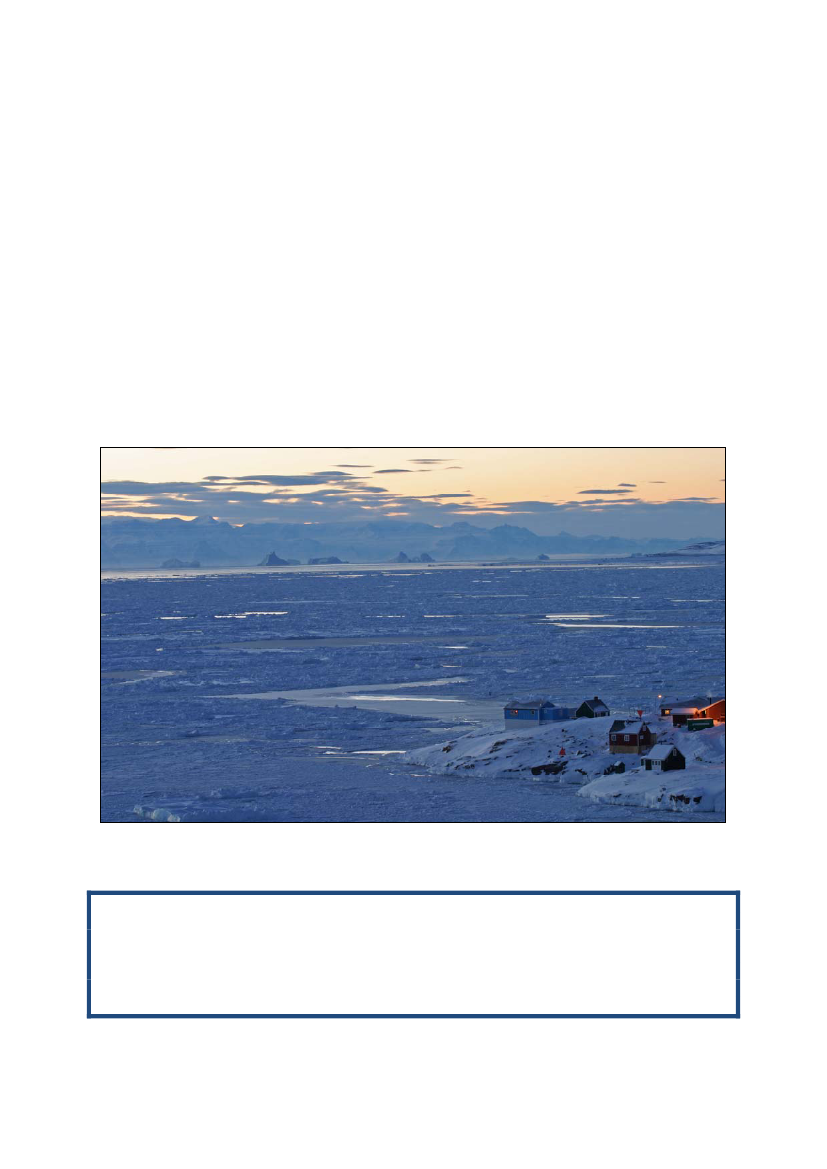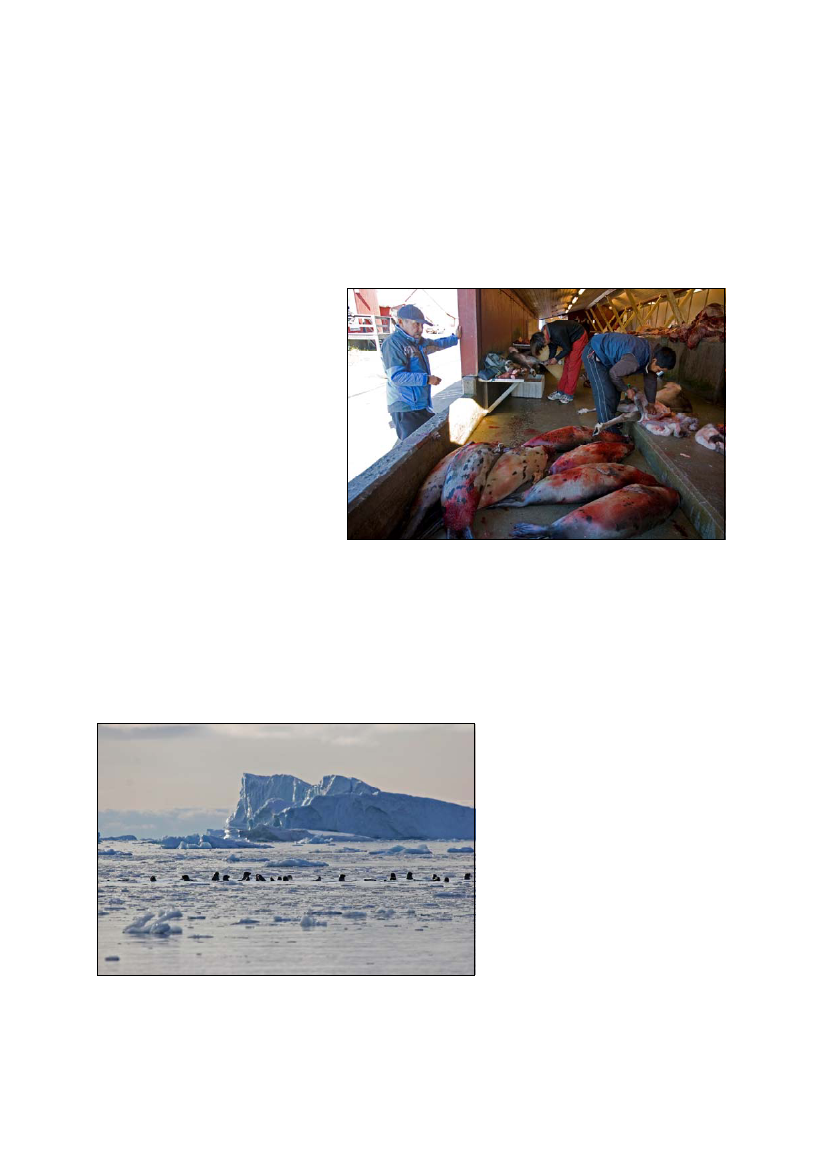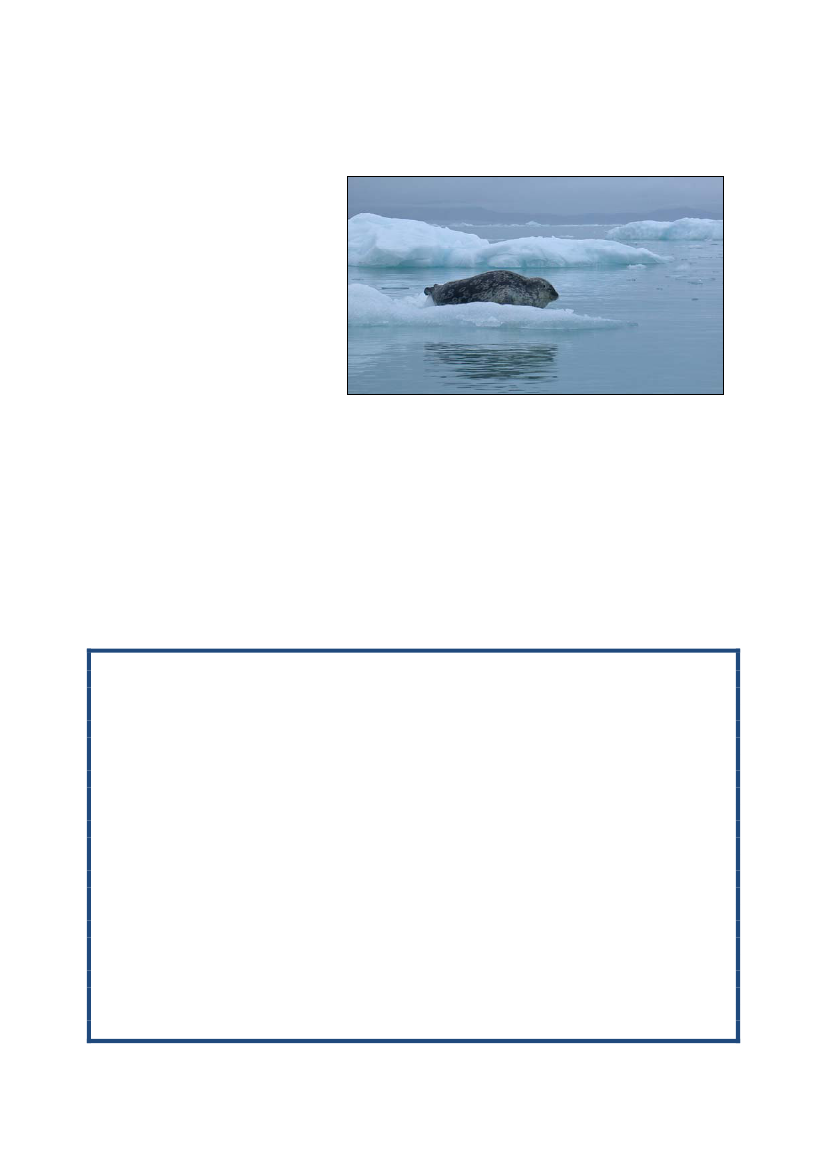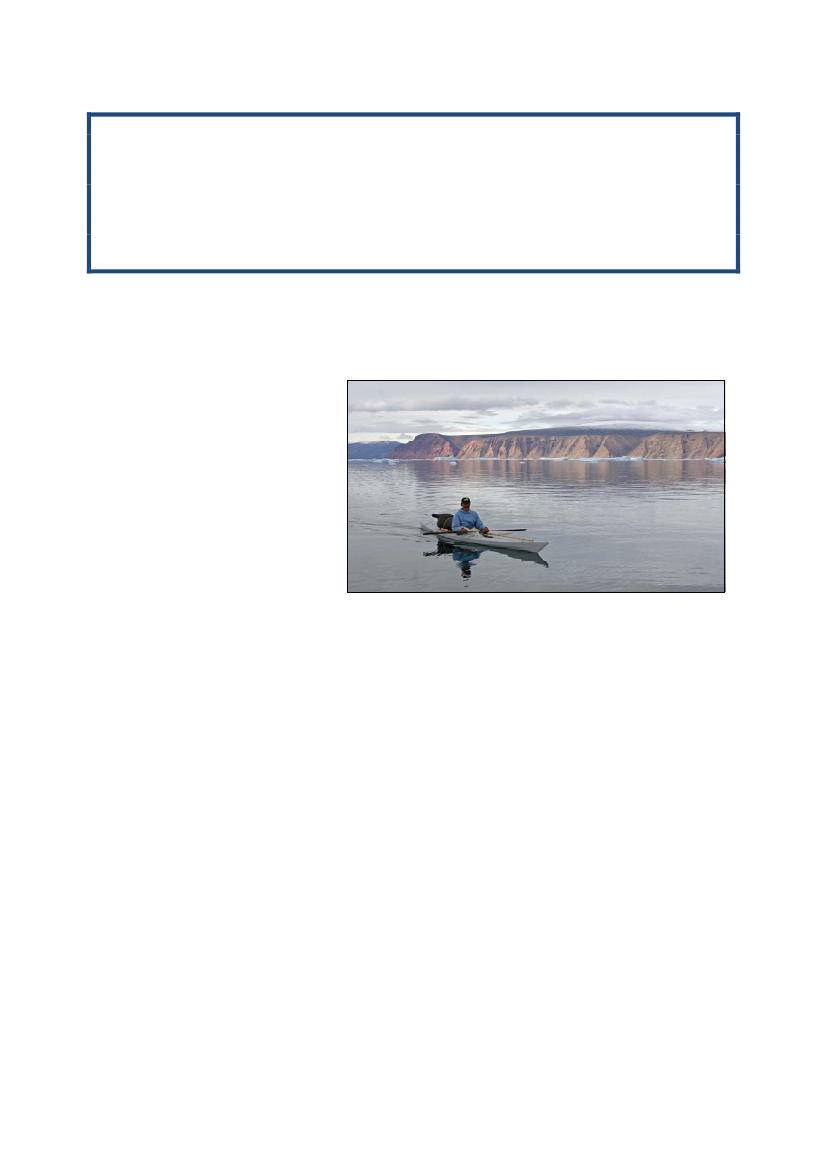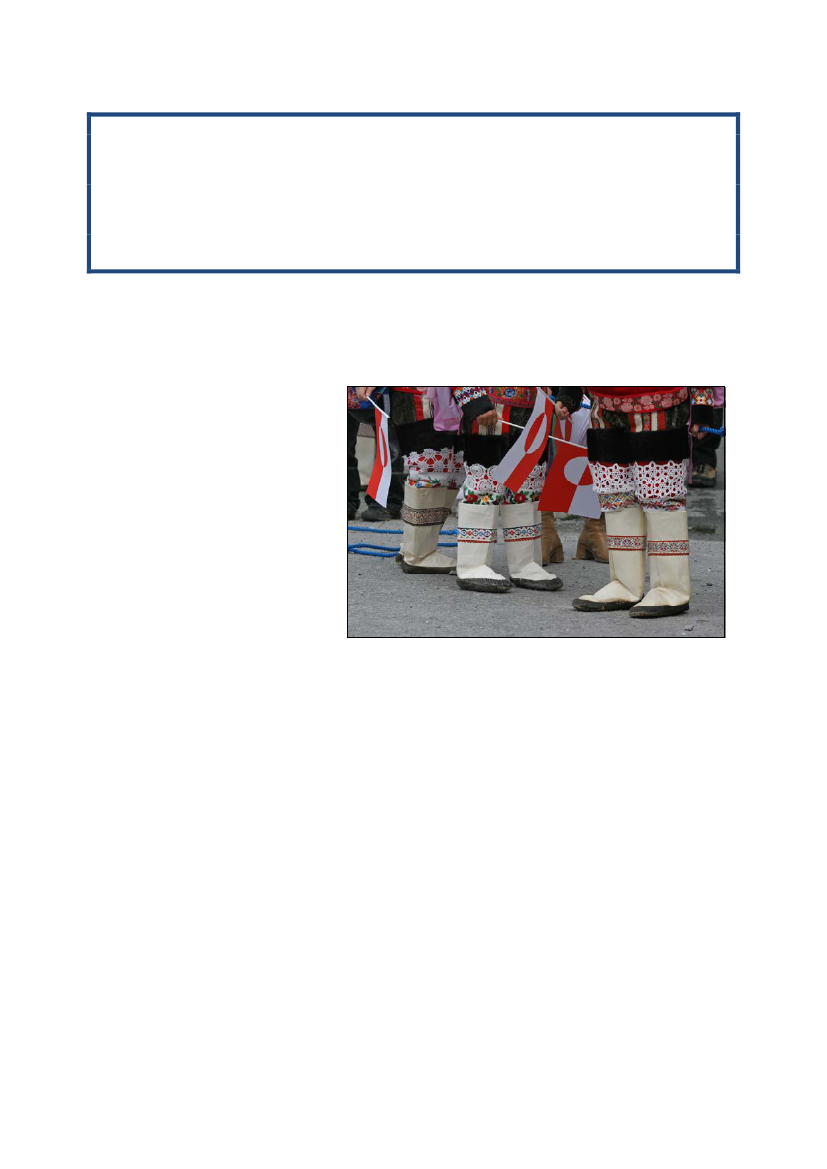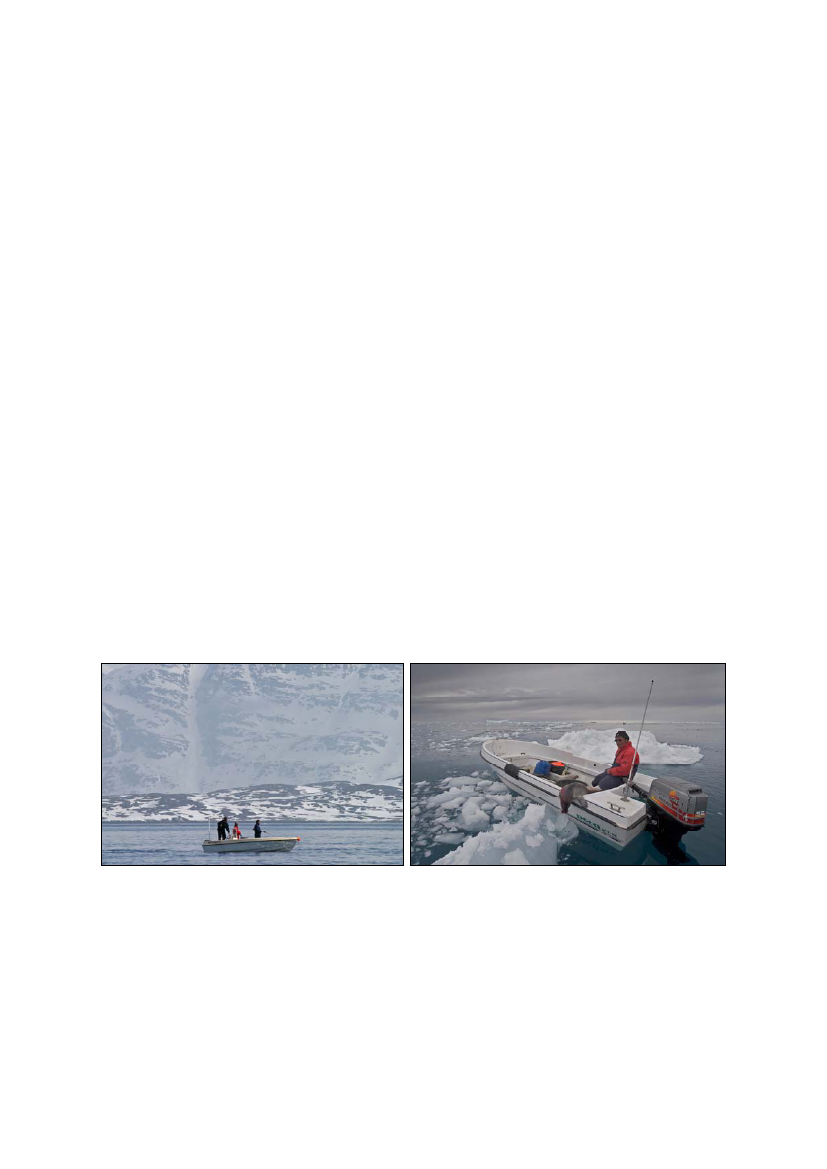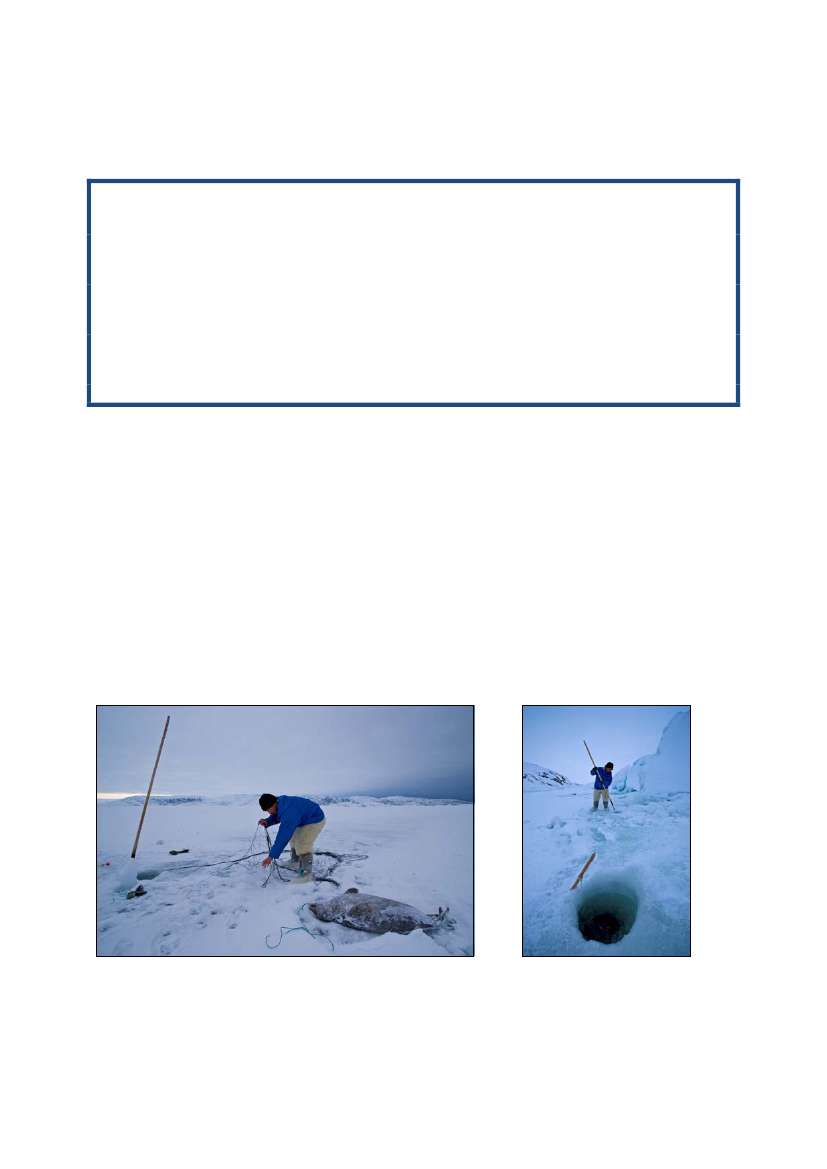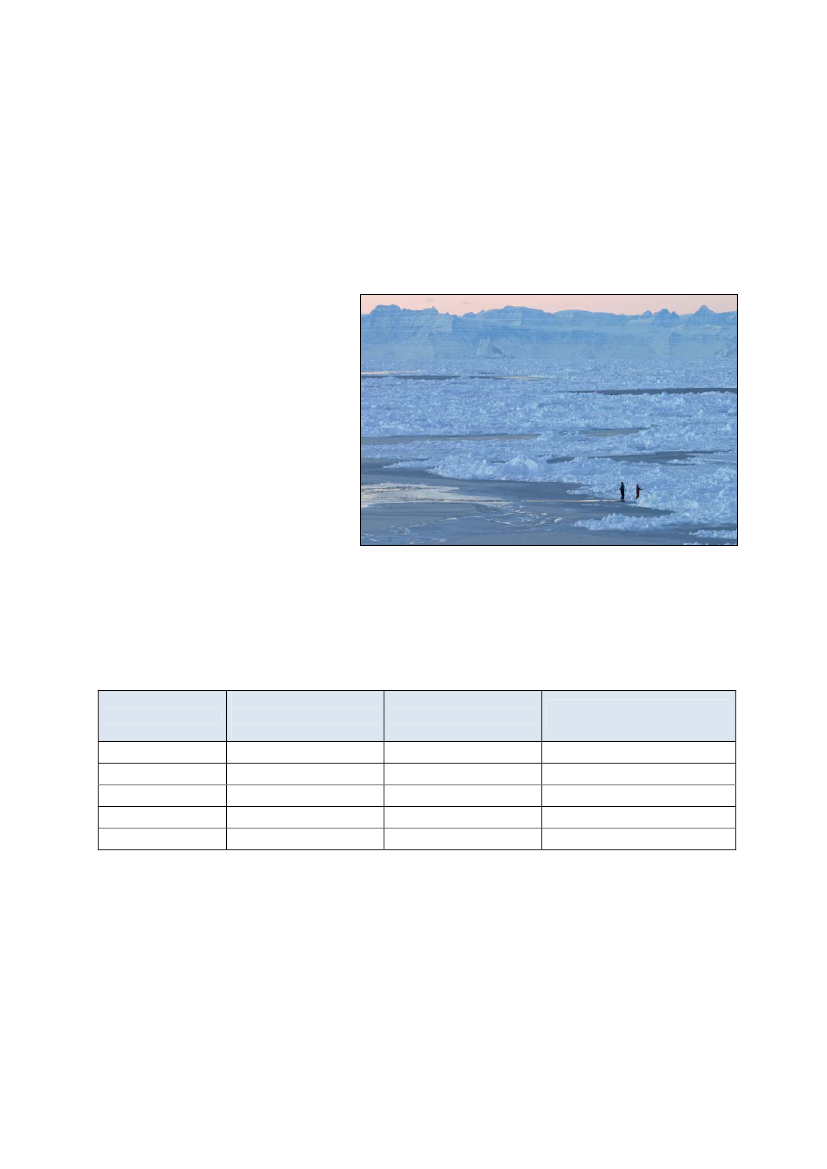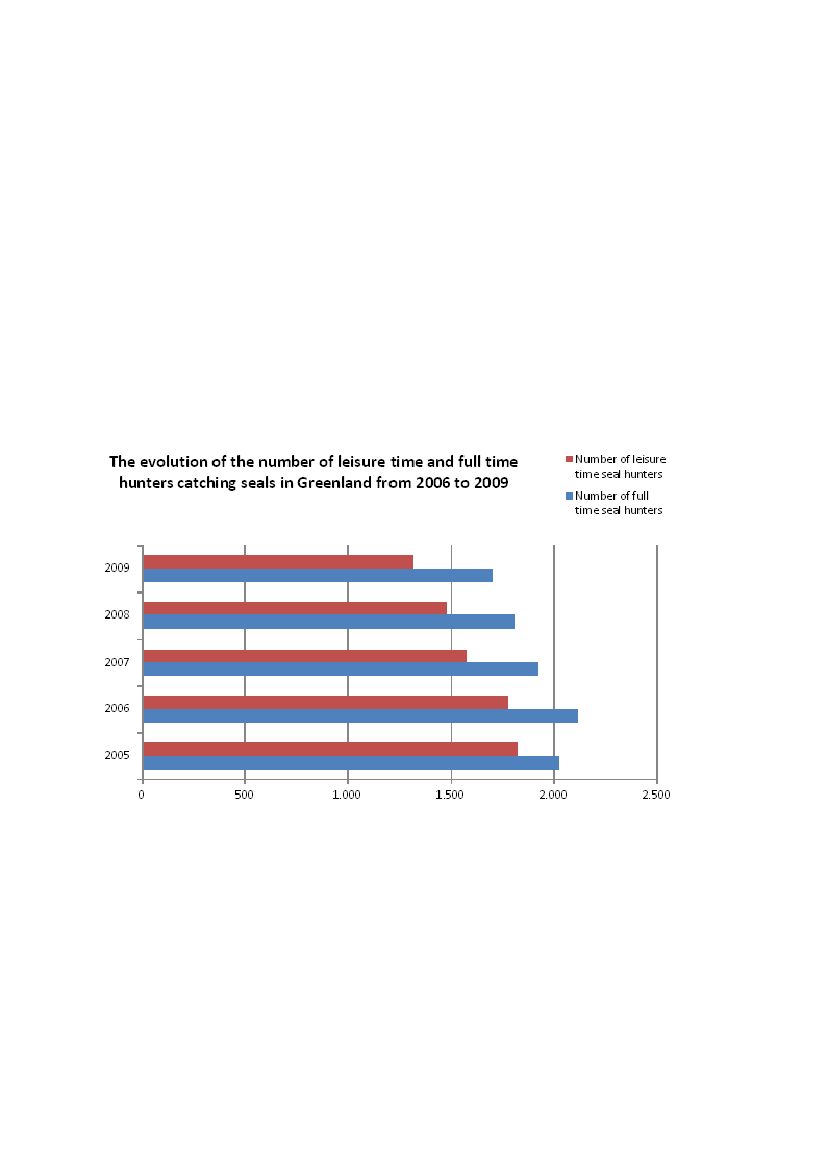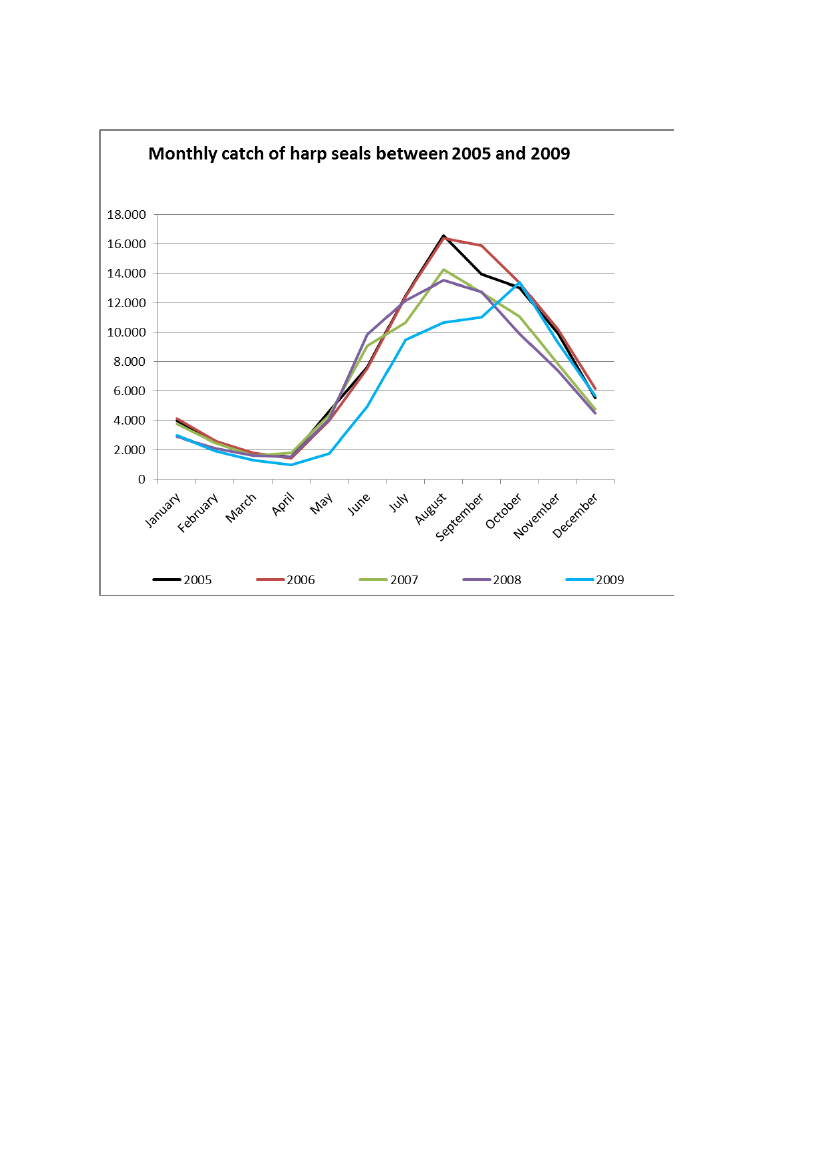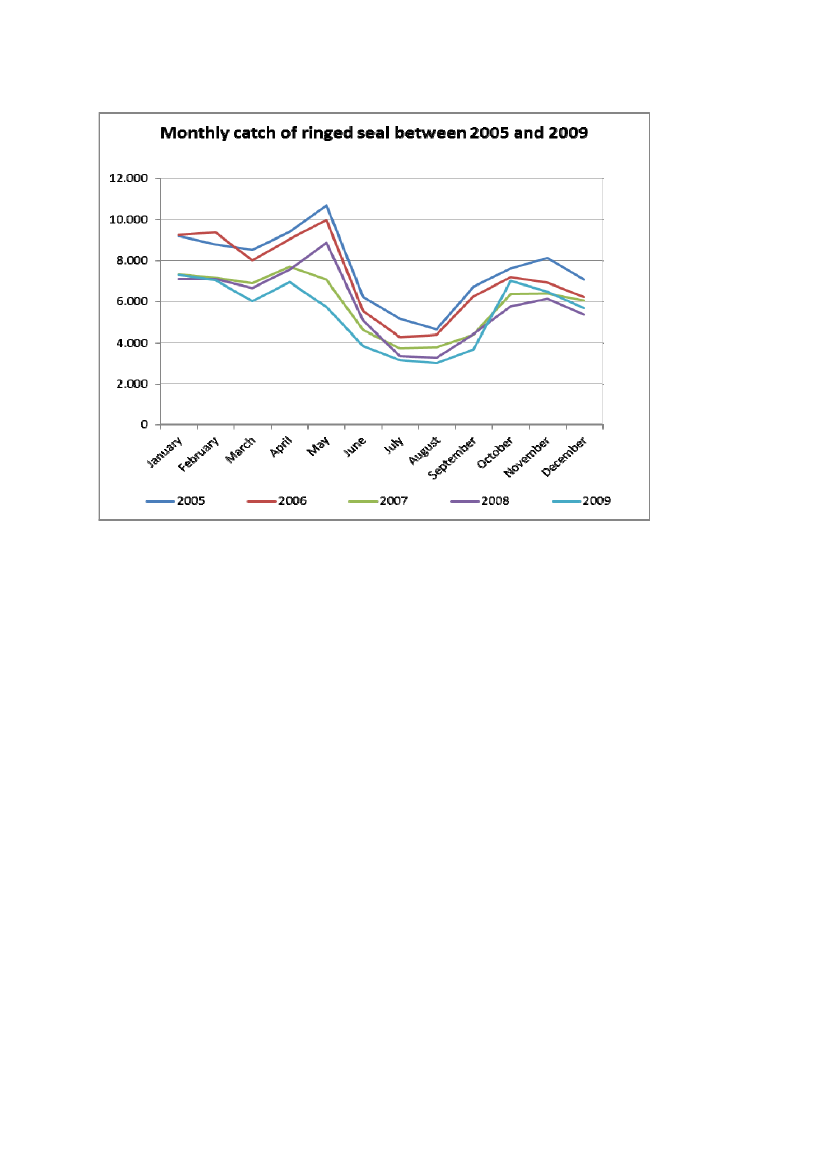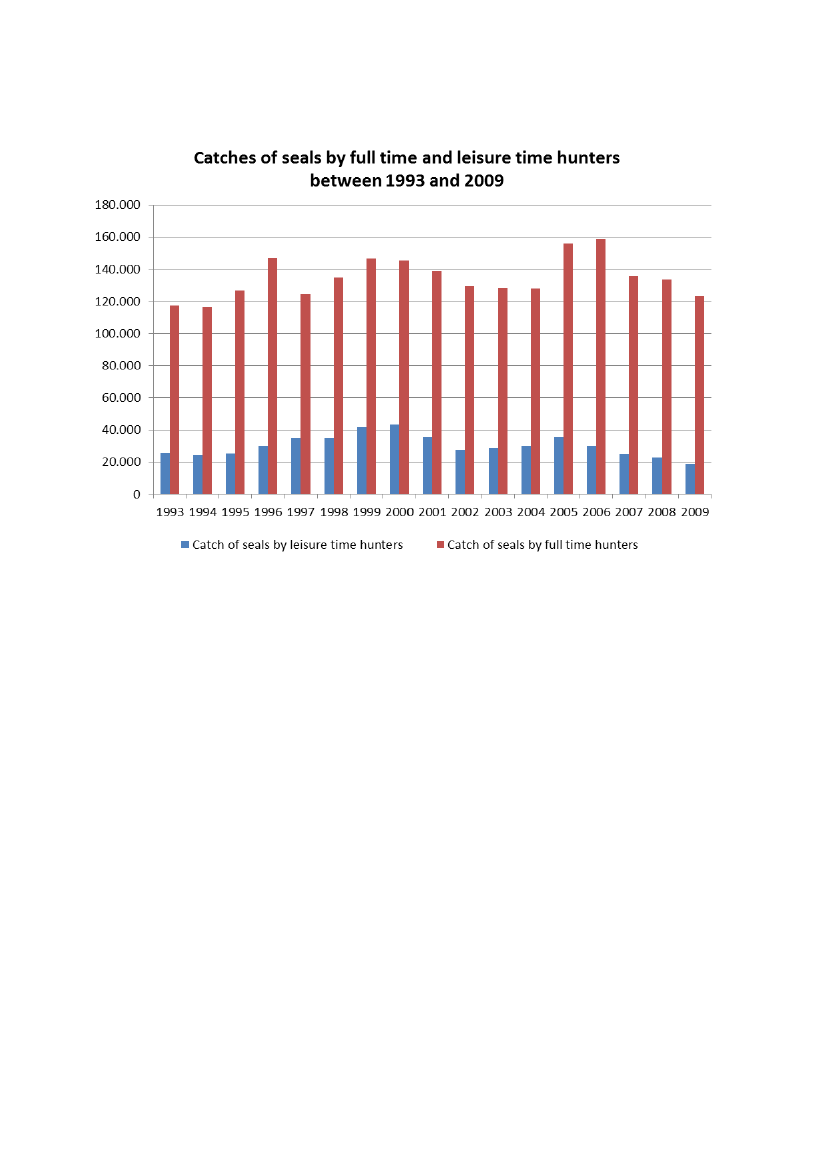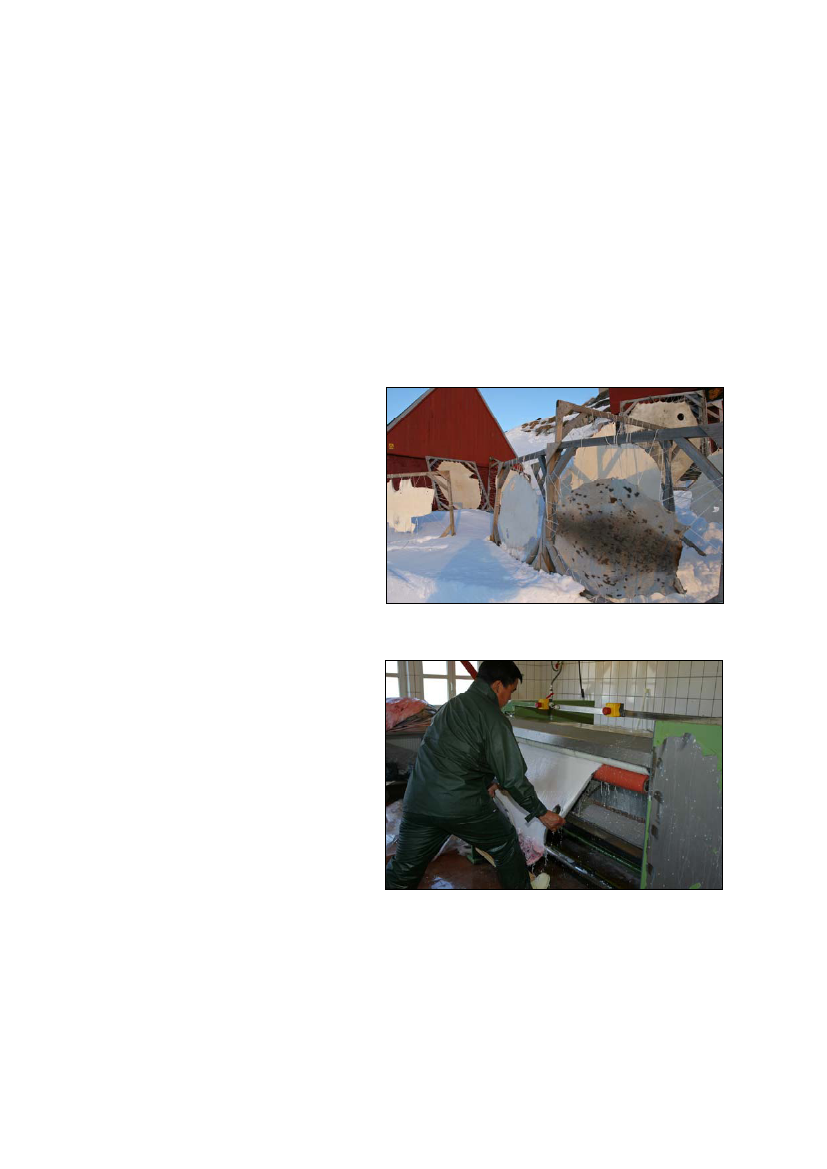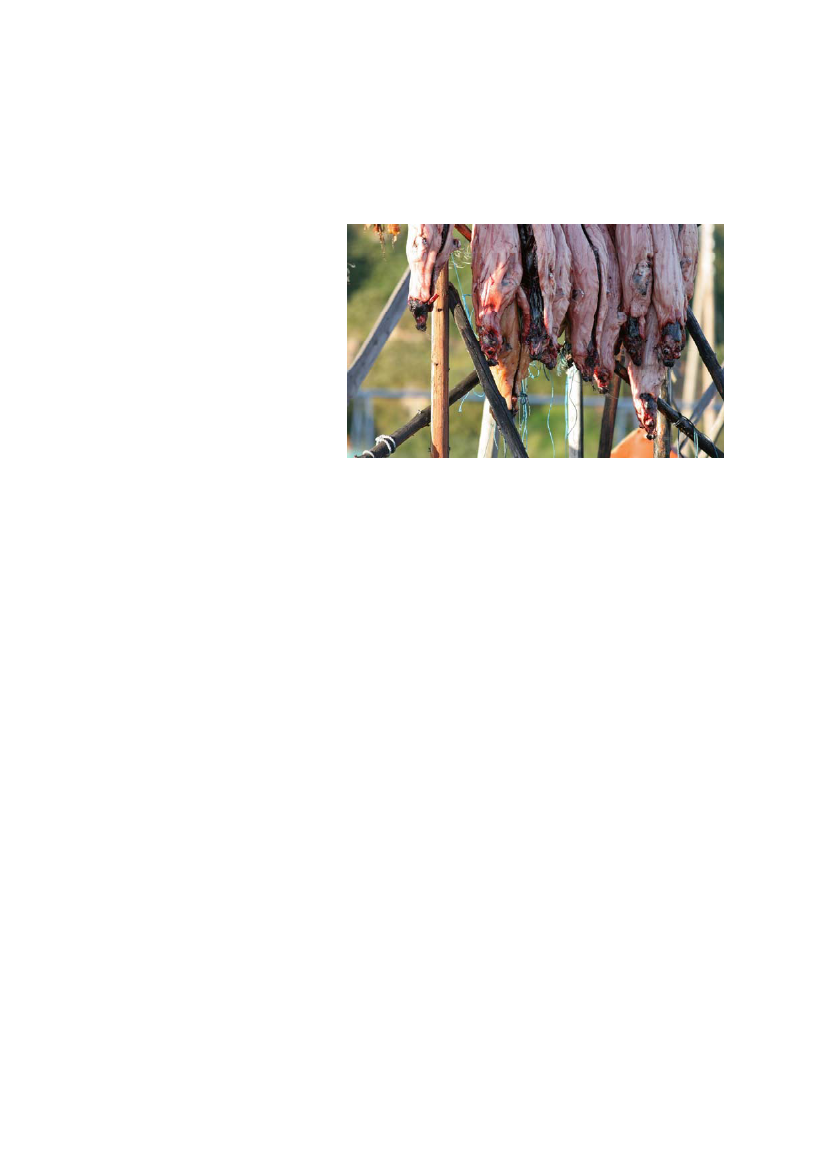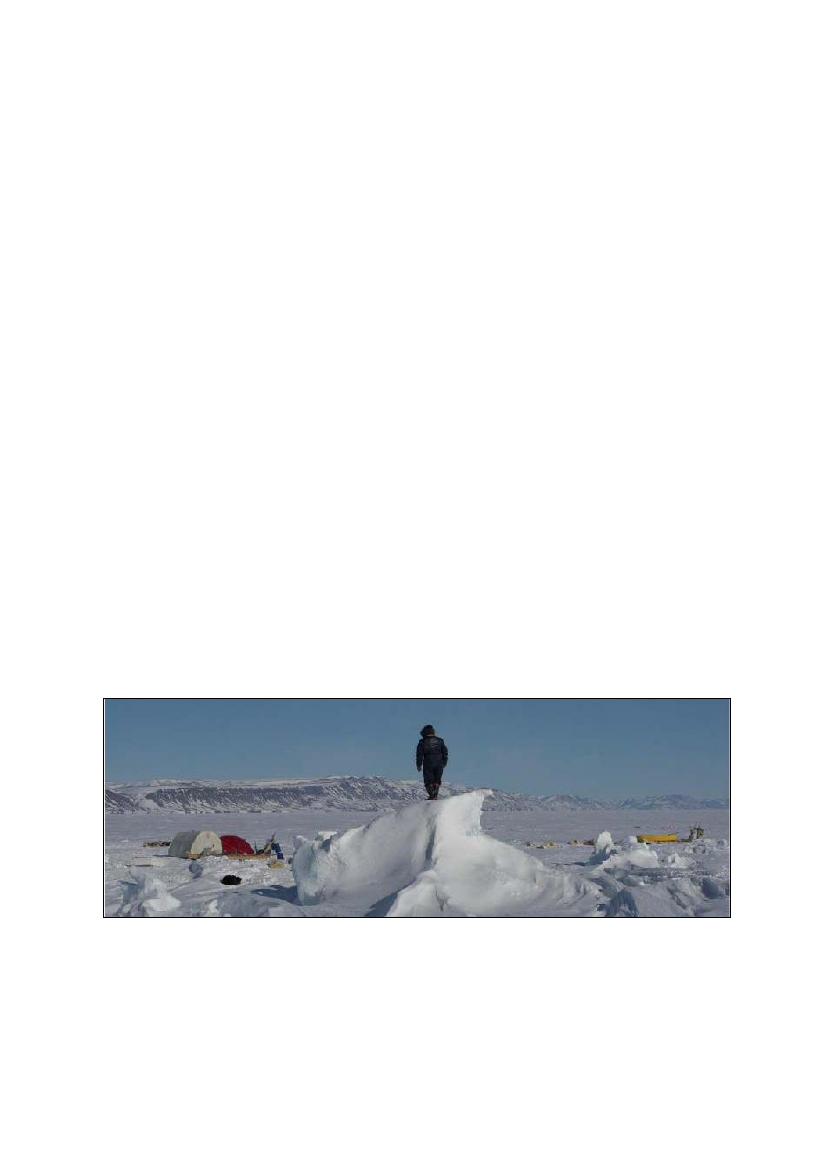Grønlandsudvalget 2014-15 (1. samling)
KOM (2015) 0045 Bilag 4
Offentligt
MANAGEMENT AND UTILIZATION
OF SEALS IN GREENLAND
THE GOVERNMENT OF GREENLAND
MINISTRY OF FISHERIES, HUNTING & AGRICULTURE
REVISED APRIL 2012
PDF to HTML - Convert PDF files to HTML files
Foreword by Honourable Minister of Fisheries, Hunting & Agriculture,
Mrs. Ane Hansen:
I have the clear opinion that challenges have to be taken on the spot and directly
with the relevant partners by equal part dialogue and mutual understanding
between the involved parties.
I have, in connection with meetings in the recent past, seen a great need for
information on seals and seal hunting to authorities, merchants and consumers
in Europe and other countries. There is very little knowledge about these topics
in Europe. In this context, I propose that the European Union that have adopted the ban, with Inuit
exemption will help us to form an information campaign so people can understand what the ban and
the exemption for Inuit means.
As a Minister for Fisheries, Hunting and Agriculture, I have advocated intensively for increased
sustainable use of all living resources in Greenland, based on sound biological advice. I have also
advocated the importance of listening to what national, international organisations and unions have to
say. I have listened to our Industry and hunters, who asked me to talk to the EU system and meet with
partners.
Greenland is a country of contrasts. We have culture and traditions that go 4000 years back in time.
The Greenlandic society is also part of the modern and developing world today, where we June 21st
2009 have gained Self Governance. It means for instance that we are and will be highly depending on
our own natural resources, including the marine resources. It also means that we have to continue our
focus on and to take care of the great nature and its richness on a higher level, so future generations
can get benefit of these in a sustainable manner.
I would also like to stress the importance of a sound ecosystem based management of all living
resources. The increasing numbers of seals in our seas are the biggest competitors to our fishermen
and hunters.
I appreciate partners who bring scientifically documented decisions first. I refer to our good fisheries
partnership agreement with EU. However, I am very worried about the EU ban on seal products with
Inuit exemption, since this is based on emotion and not facts. This trend worries me deeply, because
we have an increasing seal population in our and neighbouring waters. Currently the population is
estimated to be between 15.2 to 17.2 million seals. I have received information from a reputable
veterinarian who is deeply concerned about the risk of outbreaks of influenza in the seals. If that
happens, then I would say that it will be a major and unintended cruelty. We as responsible citizens of
the world must act balanced, so the ecosystem does not change significantly.
PDF to HTML - Convert PDF files to HTML files
On top of that Greenland is also severely affected by decisions and domestic politics in the EU and
other countries. The effect of the trade ban of seal products is one example. Even with the so-called
Inuit exemption within the EU ban, the decision has already destroyed our sealskin market. Today
there are stored about 300.000 sealskins due to a destroyed international sealskin market. The EU
should in addition to the hearing 7 of February 2012 strongly consider the ban and that there will be a
soon decision on the WTO cases which Norway and Canada has applicated for. The slow processing
of these cases also blocked the market for our products.
I have stressed in my speeches that in our effort of implementing self-governance in Greenland full
utilisation of all available resources is necessary, this of course includes all landed animals. All raw
materials have to be utilised in an effective manner and at a high level so we can limit the import of
western food, and in that way participate in the reduction of CO2 emissions. By a higher level of
utilization and increased manufacturing of our own resources, we will also reduce and limit modern
life style diseases that are occurring more often in Greenland.
Our traditional food has been evaluated by medical doctors and other scientists. The scientists
recommended Inuit not to reduce or stop eating traditional food because these products are healthier
than industrialised and imported food.
I would also like to express my understanding to our fishermen and hunters organization KNAPK
and Inuit Circumpolar Council’s (ICC) deep concerns that there might be violations of Indigenous
Peoples' Rights, and particularly on the their economic and social development. The economics of seal
hunting is very vulnerable. Our Cabinet
Naalakkersuisut
has decided to continue subsidizing the seal
hunt so that sealers can continue with income from the catch, although the sale of sealskin in the
world is destroyed. Sealing has a significant socio-economic importance for the whole of Greenland,
which provides us with fresh meat and winter supplies.
It is proved that the Inuit exemption has not helped as intended. I have with regret observed the
current development in Europe, Russia, Belarus and Kazakhstan, with the trade bans which are based
on feelings not on facts. These initiatives have severe economical and socio-economical consequence
with negative consequences for our hunters, their families and their livelihood.
Naalakkersuisut
regrets deeply that the Inuit exemption has not helped as intended. Therefore, I am
proposing that the EU supports us in an information campaign in our effort so that the ban policy
does not spread further than we have already seen in non-EU countries. As I mentioned initially, I
think it would be appropriate that the EU system, cooperates with us to inform about how to
understand the ban and the Inuit exemption.
Ane Hansen
Nuuk, April 2012
2
PDF to HTML - Convert PDF files to HTML files
Table of content:
1. SUMMARY ................................................................................................................................................................. 1
RESUMÉ
.......................................................................................................................................................................... 4
NAALISAGAQ ............................................................................................................................................................... 7
2. INTRODUCTION .................................................................................................................................................... 11
3. SEALS IN GREENLANDIC WATERS ................................................................................................................... 13
4. HISTORICAL EXPLOITATION OF SEALS IN GREENLAND .......................................................................... 15
5. BIOLOGICAL ADVICE ON SEALS IN GREENLAND ....................................................................................... 16
H
ARP SEAL
............................................................................................................................................................................... 17
R
INGED SEAL
............................................................................................................................................................................ 17
H
OODED SEAL
.......................................................................................................................................................................... 17
.
6. HUNTING METHODS IN GREENLAND WATERS
........................................................................................... 18
O
PEN WATER HUNTING
............................................................................................................................................................... 18
H
UNTING SEALS WITH NETS
.......................................................................................................................................................... 19
“U
UTTOQ
”
HUNTING
(
SNEAKING
) ................................................................................................................................................. 20
H
UNTING FROM THE ICE EDGE
...................................................................................................................................................... 20
7. CURRENT CATCH LEVELS ................................................................................................................................... 21
8. THE COMMERCIAL TRADE OF SEALSKINS IN GREENLAND
..................................................................... 25
9. REGULATIONS ON SEALS IN GREENLAND
.................................................................................................... 29
10. INTERNATIONAL CO-OPERATION ................................................................................................................. 30
11. REGULATIONS ON SEALS IN THE EU
............................................................................................................. 31
T
HE
W
RITTEN
D
ECLARATION
0038/2006 ..................................................................................................................................... 31
EU
C
OMMISSION PROPOSAL OF
23
J
ULY
2008
TO THE
EU
P
ARLIAMENT
............................................................................................... 32
R
EGULATION
(EC)
N
O
1007/2009
OF THE
E
UROPEAN
P
ARLIAMENT AND OF THE
C
OUNCIL OF
16
S
EPTEMBER
2009
ON TRADE IN SEAL PRODUCTS
32
C
OMMISSION
R
EGULATION
(EU)
N
O
737/2010
OF
10
A
UGUST
2010
LAYING DOWN DETAILED RULES FOR THE IMPLEMENTATION OF REGULATION
N
O
1007/2009 ...................................................................................................................................................................... 33
T
HE POSITION OF THE
G
OVERNMENT OF
G
REENLAND ABOUT REGULATIONS ON SEALS IN
EU ....................................................................... 33
E
FFECTIVE AND HUMANE KILLING METHODS
..................................................................................................................................... 34
12. SEALSKIN AND TRADE BARRIERS:
................................................................................................................. 35
T
HE BAN OF SEAL PRODUCTS IN THE
E
UROPEAN
U
NION AND IN THE
C
USTOMS
U
NION OF
B
ELARUS
,
K
AZAKHSTAN AND THE
R
USSIAN
F
EDERATION
.. 35
13. CONCLUSIONS ..................................................................................................................................................... 36
“I
NUIT
”,
“
SUBSISTENCE
”
AND
“
TRADITIONAL HUNTING
” ..................................................................................................................... 36
SELECTED REFERENCES .......................................................................................................................................... 38
PDF to HTML - Convert PDF files to HTML files
1. Summary
1. Species:
There are six different species of seals in the Greenlandic waters. Five of the species have been hunted for
centuries, but today the catch is focused on the harp seal, ringed seal and hooded seal with great importance to
the Inuit hunters. The seal populations hunted in Greenland's waters counts more than 12 million seals.
2. Sustainability and biological advice:
There are no quotas on seals in Greenland, as the harvest level is relatively low compared with the number of
seals. The populations of harp and hooded seals have, however, also been subjected to commercial sealing by
Canadian, Norwegian and Russian sealers, and their numbers and reproduction have, therefore, been monitored
carefully for many decades. These species are now managed after an internationally-recognized, conservative
cautionary approach within marine mammal management called Potential Biological Removal (PBR).
According to the Red List of Greenland (2007) none of the three species are endangered. The Red List's
assessments are carried out by the guidelines of the international Red List; conducted by The International Union
for Conservation of Nature (IUCN). Furthermore, in 2004, IUCN openly supported sustainable harvesting
principles in relation to the abundant seal populations; rather than protection of these species.
Harp seal:
Harp seals are divided into three populations; one that breeds in the White Sea (Russia), one in the Greenland
Sea (off Northeast Greenland) and one off Newfoundland (Canada). Most Greenland catches are from the
population shared with Canada. The latest survey result for this population is from 2008, which found that 1.6
million newborn pups were born that spring, and that this corresponds to a total population of about 8 million.
The population is believed to have increased further, so that it now counts more than 9 million seals. The current
population might be at its highest level ever; hence, higher than before the commercial hunt began. This is
possible because other components in the ecosystem, ex. cod and some of the large whales, are relatively smaller
compared to what they have been. The total allowable catch (TAC) for Canada was set to 400,000 in 2011, but
only 38,018 harp seals were taken. The Greenland catches has in the latest decade averaged 82,000/yr. harp
seals.
Ringed seal:
The world population of ringed seals is estimated to be around 5-7 million seals. Approximately 50 % of the
Greenland catch of about 78,000/yr. since 2000, is taken in Baffin Bay. The population of ringed seals in Baffin
Bay and adjacent areas is estimated to be around 1.2 million seals (NAMMCO). Sustainability of the catch is
assumed, because the ringed seal is widely and evenly distributed across most of the Arctic. They do not
concentrate in breeding areas like the harp seals, and can, therefore, not be hunted in the same industrial way.
The area, where they are hunted by the Inuit in Greenland and Canada, only constitute a tiny fraction of their
habitat.
1
PDF to HTML - Convert PDF files to HTML files
Hooded seal:
Close to all catches of hooded seals in Greenland, average of 4,600/yr., since 2000, is from the Northwest
Atlantic population, which is estimated to be around 600,000 seals (ICES/NAFO). The Canadian TAC, which
takes a free hunt in Greenland into account, is set to 8,200, but less than 100 has been taken in recent years.
3. Hunting methods in Greenland:
The catch of
harp seals
takes place all year round, but predominantly during summer and falls in
open water
and
is a small-scale hunt. The hunter localizes the seal and shoots it with a rifle. In northern Greenland during the
dark winter months
netting
is the prevailing method for the hunters to catch ringed seals. In spring, when
ringed
seals
haul-out on the ice, hunters use white screens to
sneak up
to an appropriate shooting distance and shoot the
seal dead in the head. In The European Food & Safety Agency’s (EFSA) study, the rifle hunt is accepted as a
humane hunting method.
4. The Greenlandic catch:
There are about 2,100 full time and 5,500 leisure time hunters in Greenland. Altogether, there are just under
8,000 hunters in Greenland. The full time hunters constitute almost 7 % of the work force (app. 32,000) in
Greenland (2011).
5. Economy – household as well as national:
For the 2,100 professional hunters in Greenland, the income from the seal hunt is vital. The household economy
for the hunter is mixed. The income from the seal hunt (from selling and/or giving the meat) serves as a
subsistence supplement to the barter economy still existing in small communities dispersed in Greenland. It also
serves as direct cash flow income for the hunter; namely the sale of the seal skin from which some hunters get
approx. half of their cash income covered, in order to feed their families. Often, the hunter in smaller
communities is the breadwinner of the family. The average income for a hunter’s municipality (e.g. Qaanaaq in
northern Greenland) is approx. 16,000 € (2010).
In terms of the national economy, the seal skin export has been steadily decreasing over the last couple of
decades. It used to constitute an export item, besides the dominant export of fishery products, which account for
93 % (2011). An export hindrance would create social pressure on the national economy as hunters, relying on
the cash flow income, would turn to social security benefits from the Greenlandic authorities. Furthermore, the
seal skin processing has an intra-economic value, as different seal products are sold as handicrafts, clothing,
national garments etc., some of which is sold to tourists.
6. Culture and tradition:
Seal hunting is an important part of the Inuit culture, tradition and identity in Greenland. Since the arrival of the
first Inuit, seals have provided basic nutrition as food for humans and dogs. Furthermore, items (blubber and
skin) have provided shelter, fuel, lightning, tools, covers for tents and kayaks, as well as, clothing. The seal also
plays an immense role in Greenlandic mythology. Today, the Inuit in Greenland have access to the items of the
modern world, but the seal is still hunted for food and clothing, and as part of a traditional legitimate leisure
activity, in which all parts of the seal are used or consumed.
2
PDF to HTML - Convert PDF files to HTML files
7. Rights of Indigenous Peoples:
The Inuit in- and government of Greenland call upon the declaration of the rights of Indigenous Peoples, which
all EU Member States have signed. Relevant articles related to the hindrance of commercial seal hunting are:
Indigenous Peoples have the right to freely pursue their economic […] development (art. 3)
Indigenous Peoples have the right to not be subjected to forced assimilation or destruction of their
culture (art. 8).
Indigenous Peoples have the right to be secure on the enjoyment of their own means of subsistence
[…] and to engage freely in […] economic activities (art. 20).
States shall consult […] in good faith with the Indigenous Peoples concerned […] in order to obtain the
free and informed consent prior to the approval of any project affecting their […] resources (art. 32,
§2).
8. Legislation - regulation, control and monitoring:
In Greenland, the law on hunting from 1999 and the law on protection of nature and wildlife from 2003
constitute the overall frame regarding wildlife regulation. From December 1
st
, 2010, a national executive order
regarding the protection of seals and regulation of sealing came into force. The municipalities (four) set local
regulation on seal hunting; but, as a rule of thumb, seals can be hunted all year around; provided that hunters
have a permit. There are no quotas on the seals hunted; however, the permits are used to control and monitor the
harvest, as hunters are required to report their annual catches.
9. International cooperation on seals:
Greenland cooperates with the International Council for the Exploration of the Sea’s (ICES/NAFO) Working
Group on Harp and Hooded Seals and, also, with the North Atlantic Marine Mammal Commission (NAMMCO),
which has a task force covering the studies and monitoring of seal populations. Within NAMMCO, a Seal
Management Committee has been established in 2006; chaired by Greenland.
10. International trade bans on seal skins and seal products:
The Marine Mammal Protection Act (MMPA) of the United States enacted on October 21, 1972. The Council
Directive 83/129/EEC (European Economic Community) of 28 March 1983 concerning the importation into
Member States of skins of certain seal pups and products derived therefrom. Regulation (EC) No 1007/2009 of
the European Parliament and of the Council of 16 September 2009 on trade in seal products, including an
exemption for Inuit. Commission Regulation (EU) No 737/2010 of 10 August 2010 laying down detailed rules
for the implementation of regulation No 1007/2009.
3
PDF to HTML - Convert PDF files to HTML files
Resumé
1. Arter
Der findes seks forskellige sælarter i de grønlandske farvande. Fem af disse arter har været jagede i århundreder,
men i dag er jagten koncentreret omkring grønlandssæl, ringsæl og klapmyds, som har stor betydning for Inuit.
De sælbestande, der jages i Grønland, tæller mere end 12 millioner individer.
2. Bæredygtighed og biologiske anbefalinger
Der er ikke fastsat kvoter for sælfangsten i Grønland, og antallet af fangster er lavt set i forhold til bestandenes
størrelse. Bestandene af grønlandssæl og klapmyds har imidlertid væres genstand for kommerciel fangst fra
canadisk, norsk og russisk side, og deres størrelse og reproduktion har derfor været nøje overvåget i mange
årtier. Disse arter administreres i henhold til internationalt anerkendte konservative principper inden for
forvaltning af havpattedyr, der kaldes Potential Biological Removal (PBR).
Ifølge rødlisten for Grønland fra 2007 er ingen af de tre arter truede. Rødlistens fastsættelser sker på baggrund af
anbefalingerne fra den internationale rødliste, der varetages af International Union for Conservation of Nature
(IUCN). Herudover støttede IUCN i år 2004 åbent bæredygtige fangstprincipper i forhold til righoldige
sælbestande frem for beskyttelse af disse.
Grønlandssæl
Grønlandssælen er opdelt i tre bestande: en, der yngler i Hvidehavet (Rusland), en i Grønlandshavet (ud for
Nordøstgrønland) og en ud for Newfoundland (Canada). De fleste fangster i Grønland sker fra en bestand, der
deles med Canada. Den sidste undersøgelse af denne bestand er fra 2008. Den viste, at der dette forår ud af en
samlet bestand på 8 millioner individer fødtes 1,6 millioner unger. Bestanden menes at være øget yderligere,
således at den nu udgøres af mere end 9 millioner sæler. Den nuværende bestand er måske på sit højeste niveau
nogensinde og er derfor også højere, end før den erhvervsmæssige sælfangst begyndte. Dette skyldes andre
komponenter i økosystemet f.eks. bestandene af torsk og nogle af de store hvaler er mindsket i forhold til
tidligere. Den samlede tilladte fangstmængde, Total Allowable Catch (TAC), for Canada blev i 2011 sat til
400.000, hvoraf kun 38.018 blev udnyttet. De grønlandske fangster har i det sidste årti ligget på 82.000
grønlandssæler i gennemsnit pr. år.
Ringsæl
Verdensbestanden af ringsæl antages at ligge omkring 5-7 millioner sæler. Siden 2000 er ca. 50 % af de
grønlandske fangster på 78.000 pr. år sket i Baffinbugten. Bestanden af ringsæl i Baffinbugten og tilstødende
områder anslås (iflg. NAMMCO) til at bestå af 1,2 millioner sæler. Fangsten anses for at være bæredygtig, fordi
ringsælen er jævnt og bredt udbredt over det meste af Arktis, og de samler sig ikke som grønlandssælen i
bestemte yngleområder og kan derfor ikke jages på samme industrielle måde. Området, hvori de jages af Inuit i
Grønland og Canada, udgør kun en lille del af deres habitat.
Klapmyds
Siden år 2000 er næsten alle fangster af klapmyds i Grønland med et gennemsnit på 4.600 pr. år sket fra den
nordvestatlantiske bestand, som anslås at udgøre 600.000 individer (ICES/NAFO). Den samlede tilladte
4
PDF to HTML - Convert PDF files to HTML files
fangstmængde (TAC) for Canada, som tager hensyn til den grønlandske fangst, er fastsat til 8.200, men i de
sidste år er mindre end 100 blevet fanget.
3. Jagtmetoder i Grønland
Jagt på
grønlandssæl
foregår året rundt men fortrinsvis om sommeren og i efteråret på
åbent vand
og kun i
mindre omfang. Fangeren finder sælen og skyder den med riffel. I de mørke vintermåneder i Nordgrønland er
fangst af ringsæl med
net
den mest udbredte metode blandt fangerne. I foråret, når ringsælerne trækker op på
isen, bruger fangerne hvide skærme til at
snige
sig ind på skudhold og skyder sælerne i hovedet. I et studie fra
The European Food & Safety Agency (EFSA) anerkendes jagt med riffel som en human jagtform.
4. Jagten i Grønland
Der findes omkring 2.100 fuldtidsfangere og 5.500 fritidsfangere i Grønland. I alt er der lige under 8.000 fangere
i Grønland. Fuldtidsfangere udgør næsten 7 % af den samlede grønlandske arbejdsstyrke (på ca. 32.000 i år
2011).
5. Privat- såvel som nationaløkonomi
Indkomsten fra sæljagten er af vital betydning for de 2.100 professionelle fangere i Grønland. Fangernes
privatøkonomi er blandet. Indtægterne fra sæljagten (i form af salg og/eller som ernæring) tjener som et
supplement til den bytteøkonomi, der stadig findes i de små samfund, der er spredt ud over Grønland. De tjener
også som direkte kilde til kontante penge for fangeren - nemlig i form af salg af sælskind, hvorfra nogle fangere
erhverver omkring halvdelen af den nødvendige indtægt til at underholde deres familier. I mindre fangersamfund
er fangeren ofte ene forsørger for en familie. Gennemsnitsindkomsten for en fanger i en kommune som f.eks.
Qaanaaq i Nordgrønland er omkring 119.000 kr. (for år 2010).
Set i nationaløkonomisk perspektiv har sælskindseksporten været støt faldende over de sidste årtier, hvor den
tidligere udgjorde en eksportvare sammen med den altoverskyggende eksport af fiskeriprodukter, som i år 2011
udgjorde 93 %. En begrænsning i eksporten vil skabe et socialt pres på nationaløkonomien eftersom fangere, der
er afhængige af deres kontante indtjening, vil skulle overgå til sociale ydelser fra de grønlandske myndigheder.
Ud over eksporten har bearbejdning af sælskind intern økonomisk værdi og forskellige produkter af sæl sælges
som kunsthåndværk, beklædning, nationaldragter osv., hvoraf nogle sælges til turister.
6. Kultur og tradition
Sæljagten er en væsentlig del af inuitkulturen, traditionen og identiteten i Grønland. Siden de første inuitter
ankom, har sæljagt dannet fødegrundlag for mennesker og hunde. Hertil kommer at spæk og skind har givet ly,
brændsel, lys, værktøj, telte og kajakovertræk tillige med beklædning. Sælen spiller også en umådelig stor rolle i
den grønlandske mytologi. I dag har inuit i Grønland adgang til den moderne verdens bekvemmeligheder, men
sæl jages stadig som kilde til føde og beklædning, og sæljagt er en legitim fritidsaktivitet, hvor alle dele af sælen
bruges eller konsumeres.
7. Oprindelige folks rettigheder
Inuit og Grønlands Selvstyre påkalder sig Erklæringen om oprindelige folks Rettigheder, som alle EU's
medlemsstater har tiltrådt. Relevante artikler i forhold til begrænsninger af erhvervsmæssig fangst af sæler er:
5
PDF to HTML - Convert PDF files to HTML files
Oprindelige folk har ret til [...] og kan frit udøve deres økonomiske [...] kulturelle udvikling (artikel 3).
Oprindelige folk og enkeltpersoner har ret til ikke at blive udsat for tvunget assimilation eller
ødelæggelse af deres kultur (artikel 8).
Oprindelige folk har ret til at opretholde og udvikle deres politiske, økonomiske og sociale systemer
[...] og til frit at involvere sig i [...] økonomiske aktiviteter (artikel 20).
Staterne skal konsultere og i god tro samarbejde med de berørte oprindelige folk [...] for at indhente
deres frie og informerede samtykke forud for godkendelse af ethvert projekt, der berører deres [...]
ressourcer (artikel 32, stk. 2).
8. Lovgivning - regulering, kontrol og overvågning
I Grønland udgør Landstingslov om fangst og jagt fra 1999 og Landstingslov om naturbeskyttelse fra 2003 den
overordnede ramme med hensyn til regulering af dyrelivet. Den 1. december 2010 trådte Selvstyrets
bekendtgørelse om beskyttelse og fangst af sæler i kraft. Kommunerne (fire stk.) kan regulere jagten på sæl
lokalt, men som tommelfingerregel kan sæl jages året rundt, forudsat at fangeren har jagtbevis. Der findes ikke
nogen kvoter for sælfangsten, dog bruges jagtbeviserne som overvågning, idet fangerne er forpligtede til at
oplyse deres årlige fangster.
9. Internationalt samarbejde om sæler
Grønland samarbejder med International Council for the Exploration of the Sea (ICES/NAFO) i arbejdsgruppen
vedrørende grønlandssæl og klapmyds og med North Atlantic Marine Mammal Commission (NAMMCO), som
har en task force, der dækker studier og overvågning af sælbestande. I NAMMCO blev der i 2006 etableret en
komite til forvaltning af sæler (Seal Management Committee) under formandskab af Grønland.
10. Internationale handelsbegrænsninger for sælskind og produkter fra sæl
Marine Mammal Protection Act (MMPA) (USA) af 21. oktober 1972. Rådets direktiv nr. 83/129/EØF (Det
europæiske økonomiske Fællesskab) af 28. marts 1983 om indførsel i medlemsstaterne af visse sælungeskind og
varer heraf. Europa-Parlamentets og Rådets forordning nr. 1007/2009 af 16. september 2009 om handel med
sælprodukter, herunder en undtagelse for inuit. Kommissionens forordning nr. 737/2010 af 10. august 2010 om
gennemførelsesbestemmelser til forordning nr. 1007/2009
6
PDF to HTML - Convert PDF files to HTML files
Naalisagaq
1. Puisit assigiinngitsut
Kalaallit Nunaata imartaani puisit assigiinngitsut arfineq marluupput. Taakku ilaat tallimat ukiorpassuarni
piniagaasimapput, ullumikulli piniagaanerusut Inuit piniartortaannut pingaaruteqarluartut tassaapput aataat,
natsiit aammalu natsersuit. Puiseqatigiit assigiinngitsut piniagaasut Kalaallit Nunaata imartaaniittut 12
millioninit amerlanerupput.
2. Piujuaannartitsisinnaaneq biologillu siunnersuuteqartarnerat
Puisit amerlassusiinut naleqqiullugit pisarineqartartut amerlagisassaanngimmata Kalaallit Nunaanni puisit
immikkut pisassiissutigineqarneq ajorput. Taamaattorli aataat natsersuillu canadamiunit, norgemiunit aammalu
russinit
iluanaarniutigalugu
piniarneqartarmata
taakku
amerlassusii
kinguaassiornerilu
ukiorpassuarni
malinnaaffigeqqissaarneqarsimapput. Puiseqatigiit pineqartut maanna imarmiunik mianersortumik aqutseriaatsit,
Potential Biological Removal-imik (PBR) taaneqartartut, nunallu tamalaat akuerisaat najoqqutarlugit
nakkutigineqarput.
Kalaallit Nunaanni uumasunik navianartorsiorsinnaasunik nalunaarsuiffik 2007-imeersoq naapertorlugu
puiseqatigiit pineqartut arlaannaalluunniit navianartorsiunngillat. Uumasunik navianartorsiorsinnaasunik
naliliisarneq
naammattumik
Nunat
Tamalaat
Pinngortitamik
Allanngutsaaliinermut
taarsiullugu
Suleqatigiiffiannit
IUCN-mit
najoqqutassiarineqartut naapertorlugit pisarpoq. Najoqqutassat taakku naapertorlugit IUCN-ip 2004-imi puisit
amerlassusillit
illersorneqarnissaannut
piujuaannartitsineq
tunngavigalugu
piniarneqarnissaat ammassumik tapersersorpaa.
Aataat:
Aataat ataatsimoortukkuutaanut pingasunut avissimapput; ataatsit Ruslandip Avannaani qallunaatut Det Hvide
Havimik taasami erniortuusut, ataatsit Tunup avannaata avataani erniortuusut ataatsillu Newfoundlandip
(Canada) eqqaani erniortuusut. Kalaallit Nunaanni pisarineqartartut amerlanerit aataanit Canadamiittartunit
Kalaallillu Nunaanniittartunit pisuupput. Taakku kisinneqarnerannit paasisat kingulliit 2008-meersuupput.
Paasineqarpoq upernaaq taanna aataavaqqat 1,6 millionit piaqqiarineqarsimasut, taakkulu naatsorsoraanni aataat
tamarmiullutik 8 millionit missaanni amerlassuseqarsimassapput. Aataat taakku suli amerleriaqqissimassasutut
naatsorsuutigineqaramik maanna 9 millionit sinnerlugit amerlassuseqalersimassapput. Massakkut aataat taakku
aatsaat
taama
amerlatigilersimassapput,
aamma
iluanaarniutigalugu
piniagaanertik
sioqqullugu
amerlassuserisaminnit amerlanerulersimassallutik. Tamatumunnga pissutaasimasinnaavoq uumassusileqarfimmi
suut allat (assersuutigalugu saarulliit aammalu arferit angisuut) qangaanut naleqqiullugu ikinnerulersimammata.
Canadami
aataat
pisarineqarsinnaasut
amerlanerpaaffissaat
2011-imi
400.000-inut
amerlassusilerneqarsimagaluartut 38.018-iinnaat pisarineqarput. Kalaallit Nunaanni aataat pisarineqartartut ukiut
kingulliit qulit ingerlaneranni ukiumut agguaqatigiissillugit 82.000-inik amerlassuseqartarput.
Natsiit:
Nunarsuatsinni natsiit 5-7 millionit missaanni amerlassuseqartutut missingerneqarput. 2000-imiit ukiumut natsiit
pisarineqartartut 78.000 missaanniittartut affaat Baffinimip Ikerani pisarineqartarput. Baffinip Ikerata imartallu
tassunga atasut natsii 1,2 millionit missaanni amerlassuseqassangatinneqarput (najoqqutaq: NAMMCO). Pisat
7
PDF to HTML - Convert PDF files to HTML files
ikiliartuutaanngitsutut naatsorsuutigineqarput tassami natsiit Issittumi assigiiaamik siammarsimammata.
Aataatulli
piffimmi
ataatsimi
amerlasoorsuullutik
piaqqiorneq
ajorput,
taamaammallu
amerlasoorsuakkuutaarlutik iluanaarniutigalugu pisarineqassanatik. Kalaallit Nunaanni Canadamilu Inuit
piniarfigisartagaat natsiit uumaffigisaata ilamineeraanannguaraa.
Natsersuit:
Natsersuit Kalaallit Nunaanni pisarineqartartut 2000-miilli agguaqatigiissillugu ukiiumut 2000 missaanni
amerlassuseqartartut,
naapertorlugu
tamangajammik
missaanni
Atlantikup
Kitaata
avannaaneersuupput,
Canadamiut
pisassat
taakkulu
ICES/NAFO
600.000
amerlassuseqarput.
amerlanerpaaffissaannik
aalajangigaat, Kalaallit Nunaanni killilersugaannginnerat ilanngullugu naatsorsorneqartartut, 8.200-inut
amerlassusilerneqarput, taamaattorli ukiuni kingullerni 100-init ikinnerusut pisarineqartarput.
3. Kalaallit Nunaanni piniarnermi periaaserineqartartut:
Aataat
ukioq kaajallallugu piniagaasarput, annermilli
sikuutinnagu
aasakkut ukiakkullu piniarneqartarlutik,
aamma amerlasuukaarlugit pisaqartoqarneq ajorpoq. Piniartup aataaq sumiissusersisarpaa qoorortuumillu
aallaasarlugu. Kalaallit Nunaata Avannaani ukiukkut kaperlatsillugu
qassusersorneq
annermik piniartunit
puisinniarnermi
atorneqartarpoq.
Upernaakkut
natsiit
qassimasalersillugit
piniartunit
taalutserluni
uuttorniarnikkut piniarneqartarput. Europami Inuussutissalerinermut Isumannaallisaanermullu Suleqatigiiffiup
(EFSA) misissuinerani qoorortoorsorluni piniarneq naalliutsitsinani piniarnertut akuerisaavoq.
4. Kalaallit Nunaanni pisarineqartartut:
Kalaallit Nunaanni inuussutissarsiutigalugu piniartut 2.100 missaanni amerlassuseqarput sunngiffimminnilu
piniartartut 5.500 missaanni amerlassuseqarlutik. Kalaallit Nunaanni piniartartut katillugit 8.000 inulaarpaat.
Kalaallit Nunaanni 2011-imi sulisinnaasut 32.000 missaanniittut 7%-iisa missaat inuussutissarsiutigalugu
piniartuupput.
5. Aningaasarsiorneq – inoqutigiinni inuiaqatigiinnilu tamani:
Kalaallit
Nunaanni
inuussutissarsiutigalugu
piniartunut
2.100
missaanniittunut
puisinit
isertitat
pingaaruteqarluinnartuupput. Piniartukkormiut isertitaat assigiinngitsunit pisarput. Puisinniarnermit pissarsiat
(tuniniaanikkut aamma/imaluunniit pajuttortarnikkut) Kalaallit Nunaanni inoqarfinni mikisuni siammarsimasuni
pajuttortarluni inuussutissarsiornermi suli atuiffiusuni inuussutissaqaataalluartarput. Aamma piniartumut
toqqaannartumik aningaasarsissutaasarpoq, ilaquttaasunut inuussutissaqartitsiniarnermut atorneqartarlutik –
annermik puisip amia isertitsissutaasarpoq, ilaatigut piniartut isertitaasa affaasa missaaniittarluni. Amerlasuutigut
nunaqarfinni
mikisuni
piniartoq
ilaqutariinnik
inuuniarnikkut
pilersuisuusarpoq.
Aqutsiveqarfinni
piniartoqarfiusuni (soorlu Kalaallit Nunaata Avannaani Qaanaami) piniartup isertitai ukiumut 119.000 kr.-it
missaanni amerlassuseqartarput (2010).
Nunap tamarmi aningaasarsiornera eqqarsaatigalugu puisit amii avammut nioqqutigineqartartut ukiut kingulliit
qulikkaat ingerlaneranni ikiliartorsimapput. Avammut tunisanut annermik aalisakkanit tunisassiaasunut,
avammut
tunisat
93%-erisartagaannut,
puisit
amii
tapertaasaraluarput.
Nunaanni
Avammut
pisortaniit
nioqquteqarnerup
isumaginninnermi
ajoquserneqarnera nunap aningaasarsiornera eqqarsaalugu inuttut ajornartorsiortitsilissaaq tassami piniartut
aningaasanik
pisariaqartitsisarnertik
pissutigalugu
Kalaallit
8
PDF to HTML - Convert PDF files to HTML files
ikiorsiissutinik isumalluuteqalersussaammata. Avammut tunisassiornermut ilanngullugu puisit amiinik
suliareqqiisarneq immini immikkut naleqalersarpoq kiisalu puisinit pissarsiat assigiinngitsut sanalukkatut,
atisatut, kalaallisuutut nioqqutigineqartarput ilaatigut takornarianut tunineqartarlutik.
6. Kulturi ileqqutoqqallu:
Puisinniarneq Kalaallit Nunaanni Inuit kulturiannut, ileqqutoqaannut kinaassusaannullu pingaaruteqarpoq. Inuit
tikeqqaarmatali puisit inunnut qimminullu ulluinnarni inuussutaasimapput. Taakku saniatigut puisinit pissarsiat
allat, orsua amialu, oqqiffissaqartitsisarsimapput, kiassaataallutik, qaammaqqutaallutik, sakkugineqarlutik,
tuperni qalerarineqarlutik qaannanilu amerineqartarlutik atisarineqartarlutillu. Puisit aamma Kalaallit Nunaanni
oqaluttuatoqqani
pingaarutilissuupput.
Ullumikkut
Kalaallit
Nunaanni
Inuit
sunik
nutaalianik
pissarsisinnaagaluartut taamaattoq puisit nerisassatut atisassatullu suli piniarneqartarput kiisalu sunngiffimmi
sammisaqaataasarlutik, puisilu tamarmi atorneqartarluni nerineqartarluniluunniit.
7. Nunap inoqqaavisa pisinnaatitaaffii:
Kalaallit Nunaanni Inuit Naalakkersuisullu, Nunat Inoqqaavisa Pisinnaatitaaffii EU-mut ilaasortat tamakkerlutik
atsioqataaffigisimasaat matumuuna innersuussutigaat. Tassani aalajangersakkat ilaat puist iluanaarniutigalugu
piniarneqarnerannik akornusersuinermut tunngasuupput:
Nunat Inoqqaavisa pisinnaatitaaffigaat nammineq aalajangersaanissaq. Pisinnaatitaaffik tamanna
kiffaanngissuseqarlutik
piorsarsinnaallugu
namminneq
aningaasarsiornikkut,
[...]
aamma
kultureqarnikkut ineriartornissartik (aalajangersagaq 3).
Nunat inoqqaavi inuiaat inuillu ataasiakkaat pisinnaatitaapput inuiannut allanut pinngitsaaliissummik
ilanngutivitsitaannginnissamut imaluunniit kultureqarnermik aserunnginnissaannut (aalajangersagaq
8).
Nunat inoqqaavisa pisinnaatitaaffigaat namminneq naalakkersuinikkut, aningaasarsiornikkut aamma
inooqatigiinnermi
(aalajangersagaq 20).
Naalagaaffiit pisussaapput siunersiuissallutik aamma ajunngitsussamik siunertaqartumik nunat
inoqqaavinik pineqartunik taakkua [...]kiffaanngissuseqartumik aamma paasinnilluni akuersineq
anguniarlugu
suliniummik
sumilluunniit
[...]
isumalluutinilluunniit
allanik
attuisumik
akuersissuteqannginnermi( aalajangersagaq 32 imm. 2).
8. Inatsisit – malittarisassaqartitsineq, nakkutilliineq malinnaaviginninnerlu
Kalaallit Nunaanni piniarnermjut inatsit 1999-imeersoq aammalu pinngortitap uumasullu illersorneqarnissaannik
inatsit 2003-imeersoq uumasut nujuartat pillugit malittarsissiornermi tunngaviliisuupput. 2010-imi decemberip
aallaqqaataani puisit illersorneqarnissaat puisinniarnerullu malittarisassaqartinneqarnissaa pillugu nalunaarut
atuutilerpoq. Kommunit (sisamaasut) puisinniarneq pillugu malittarisassiorsinnaapput, taamaattorli piniartut
piniarnermut akuersissuteqarsimappata nalinginnaasumik ukioq kaajallallugu puisinniartoqarsinnaasarluni.
Puisinniarneq killilersuiffigineqanngilaq, taamaattorli piniartut akuersissummik pissarsissagunik ukiumut
pisaminnik
nalunaarsuisussaatitaammata
akuersissutit
atorlugit
pisat
nakkutigineqartarput
malinnaavigineqarlutillu.
aaqqissukkatik
imaluunniit
suliffisik
attatissallugit
[...]
aamma
kiffaanngissuseqartumik qangaaniit kingornussatik allallu pissaqarniarnikkut suliat atorsinnaassallugit
9
PDF to HTML - Convert PDF files to HTML files
9. Puisit pillugit nunat tamalaat akornanni suleqatigiinneq
Kalaallit Nunaat, Imartat misissuiffigineqartarnerat pillugu Nunat Tamalaat Siunnersuisoqatigiiffianni
(ICES/NAFO) aataat natsersuillu pillugit suleqatigiissitamut kiisalu Atlantikup Avannaani Miluumasut Imarmiut
pillugit Ataatsimiititaliamut (NAMMCO), puisit misissuiffigineqartarnerannut malinnaavigineqarnerannullu
suligasuartartoqatigiinnut suleqataavoq. NAMMCO-p iluani Puisit pillugit Aqutsinermut Ataatsimiititaliaqarpoq
2006-imi pilersitaasumik Kalaallillu Nunaanniit siulittaasuuffigineqartumik.
10. Puisit amiinik puisinillu pissarsianik nunat tamalaat nioqquteqaqqusiunnaarnerat
USA-mi Miluumasut Imarmiut Illersorneqarnissaannik Inatsit 1972-imi oktoberip ulluisa 21-ianni atuutilerpoq.
Europamiut Siunnersuisoqatigiiffiata/EU-p peqqussutaa 83/129 1983-imi marsip 28-ianneersoq puiseeqqat
amiinik taakkunanngalu nioqqutissianik nunanut ilaasortaasunut eqqussuinermut tunngasoq. Europa-Parlamentip
malittarisassiaa (EU) nr. 1007/2009-imeersoq kiisalu Europamiut Siunnersuisoqatigiiffiata malittarisassiaa 2009-
imi septemberip ulluissa 16-iaanneersoq puisinit tunisassianik nioqquteqarnermut tunngasoq, Inuit tunisassiaasa
eqqugaannginnissaannut tunngasortalik. EU Kommissionip malittarisassiaa nr. 737/2010 2010-mi augustip
ulluisa qulinganneersoq malittarisassap nr. 1007/2009-imi qanoq atortinneqarnissaanik sukumiisunik
najoqqutassiorfiusoq.
10
PDF to HTML - Convert PDF files to HTML files
2. Introduction
In June 2009 Kalaallit Nunaat / Greenland obtained status of Self-Government with a population still
dependent on subsistence hunting. It has a population of 56,600 people living in 18 towns and 60
settlements. The area in Greenland is 2,166,086 square kilometres, covering an area from Norway to
Sahara and with a coastline of 44,087 kilometres. Inuit is about 90 % of the total population, and has
maintained a lifestyle connected to the sea and the harsh nature and environment. Greenland faces a
paradox created by its traditional image in the world and its need for economic sustainability and
development.
The hunting of seals is a vital component of everyday life and culture in Greenland. It provides a
significant amount of nutritious food and income to families living in remote coastal communities.
Harp, ringed and hooded seals are the three most important species; they are hunted in every
settlement through the year as a one man activity from small boats or by the use of sledge dogs. The
skin is used as a part of the national suit and for hunting equipment. The fur is also used as a beautiful
part of modern clothing and design.
Therefore, sealing and Greenland are inseparable. Until a couple of decades ago, sealing was the
principal occupation in the winter-ice areas. There are still parts of Greenland where sealing is the
most important component of peoples livelihood, combined with other forms of hunting. Seal hunting
acts also as a supplement to fishing activities and is an economic buffer for families when no other
income sources are available. It is documented that seal meat and other seal products such as organs
and blubber are a vital source of proteins and omega-3 fatty acids. So what may not be so obvious for
everyone is that consuming seal meat has huge advantages for the protection of the environment and
for the health of Kalaallit / Inuit in Greenland.
Archaeological investigations and discoveries have shown that the Greenlandic culture always has
been based on the harvest of ringed and harp seals in addition to three other seal species. The
introduction of fisheries in certain winter-ice areas has not weakened the importance of seal hunting
in any significant way, particularly not in remote coastal communities. Yet, for many hunters the main
source of income has shifted from sealskin to Greenland halibut for instance, but the importance of the
seal as the dominating daily dish remains unchallenged. Seal meat is also indispensable as food for
sledge dogs, which power the sledges from which ice-fishing takes place.
Through a traditional way of life for many generations the Inuit have developed an in-depth
knowledge of the ecosystems in which they live. As hunters, they become part of the same ecosystems
as their prey and accurate observations and interpretations about wildlife behaviour, weather patterns
and other environmental factors are essential for survival. Aside from hunting, Inuit have
traditionally spent hours observing and discussing the animals, the sea and the land. Lessons were
learned and the knowledge base became fine-tuned through direct experience of a subsistence
lifestyle. The respect for wild animals educated Inuit on how to use and preserve the wildlife
resources for future generations.
11
PDF to HTML - Convert PDF files to HTML files
Among the problems the Inuit face are the lack of understanding of the Arctic way of life, resulting in
the seal ban with the Inuit exemption in the EU and the on-going climate changes in the Arctic
regions. Weather and ice conditions are changing and attempts are made at both local and national
level to adapt to what seems to be severe and lasting changes in the Arctic environment. Hunters are
forced to change practice and invest in new equipment. The traditional use of dog sledge is in many
areas no longer possible for several months of the year as the ice conditions have changed profoundly.
The behaviour of the ice is completely unpredictable compared to a few years ago.
The Inuit of Kalaallit Nunaat would deeply appreciate your understanding and
your support to protect our way of life and culture. Qujanaq
Box 1: Hunting seals – a daily activity
Income earned from wage occupations in the areas of services, administration, construction and mining,
supplements the native domestic economy. However, most Inuit consider themselves to be hunters on either a
full-time or part-time basis, balancing casual or seasonal wage employment with hunting. To those Inuit
employed full-time as wage earners, weekend and part-time hunting remains an important means of
supplementing their food supplies with preferred kinds of meats. Hunting is valued for its contributions to
independence, self-esteem and respect from others, traditions, and a healthy lifestyle.
12
PDF to HTML - Convert PDF files to HTML files
3. Seals in Greenlandic waters
Six different species of seals are found in the waters surrounding Greenland. These are Harp Seal
(Phoca
groenlandica),
Ringed Seal (Phoca
hispida),
Hooded Seal (Cystohora
cristata),
Harbour Seal (Phoca
vitulina),
Bearded Seal (Erignathus
barbatus)
and Grey Seal (Halichoerus
grypus).
The five first species
have been hunted for centuries, and today, especially the catch of harp seal, ringed seal and hooded
seal are of great importance to the Inuit hunters and their families. However, harp seals and ringed
seals are without doubt the two most
important
species
in
relation
to
income and food supply. These two
species comprise about 98 % of the
total catch in 2009.
The
presence
of
grey
seal
in
Greenland was documented for the
first time in August 2009
near
Cape
Farewell
at
the
south
tip
of
Greenland. The current status of this
species remains unknown.
Figure 1. Daily scene of newly caught seals and other animals being made ready for sale at the local
open air market “Kalaaliaraq” in Nuuk.
Harp seals
give birth to their offspring in late February –early April on dense pack ice concentrations
in three regions: in the White Sea in Northern Russia, in the Greenland Sea around Jan Mayen and by
Newfoundland. After their annual moult, which occurs in about the same areas as where the young
are born, harp seals disperse out over the northern Atlantic Ocean. Harp seals from the whelping
grounds off Newfoundland arrive in
Southwest
Greenland
in
large
numbers in May-June and later during
the summer and autumn disperse
along the coasts northward. In late
autumn, harp seals leave the northern
regions and most go back to the
breeding
sites,
some,
however,
primarily young animals, winter in the
waters of the Arctic.
Figure 2. A group of harp seals with
their heads up for breathing and spying “amisut”.
13
PDF to HTML - Convert PDF files to HTML files
Ringed seals
are widely distributed in Greenland waters and do not occur in dense concentrations,
but are dispersed over large areas. They are hunted year round by various methods, none of which
appear
to
exercise
a
significant
pressure on the population. Ringed
seals depend on ice-cover to make
lairs for hauling-out and pupping.
They are able to maintain open holes
in fast ice up to 2.6 m thick. Especially
in Northwest and East Greenland,
ringed seals are very abundant due to
their preferred habitat in areas with
dense ice conditions. This also makes
them a preferred prey to polar bears.
Figure 3. A ringed seal on an ice floe.
Hooded seals
give birth to their offspring at the end of March on pack-ice concentrations in three
regions: in the Greenland Sea around Jan Mayen, in the middle of the Davis Strait and by
Newfoundland. Hooded seals from the latter two breeding sites migrate to West Greenland and
Southeast Greenland and the Denmark Strait. In mid-summer, from the middle of June to the end of
July, hooded seals gather on pack ice to complete their annual moult. There are two known moulting
areas: one north of Jan Mayen and one in the Denmark Strait. Hooded seals from Jan Mayen usually
remain east of Greenland and existing data suggest that the hooded seals caught in Greenland almost
exclusively originate from Newfoundland and the Davis Strait, and not from the Jan Mayen
population.
Box 2: Abundant seal populations
Harp seal:
Advice on sustainable use on harp seal is given by a working group under the International Council
for the Exploration of the Sea (ICES/NAFO). The working group consists of scientist from Norway, Canada,
Greenland and Russia. The stocks are surveyed by estimating pup production. The total number of seals in the
stock is calculated by estimating the number of pups, and data on age-distribution in the stock, age of sexual
maturity and the rate of adult females reproducing.
For the first many years the working group calculated quotas no higher than the stock would continue growing.
The working group is now working on introducing new principles of advice, which also permits the different
countries to manage the seals from an ecological or socioeconomic perspective.
For example depending on sealskin prices the quota can increase or decrease, as long as the stock is not reduced
to less than 70 % of the maximal stock size. If the stock gets below 70 %, of the maximal size, a management
plan should be initiated with the purpose of increasing the stock above 70 % again. If the stock gets below 50 %,
further protection measures should be initiated, and if the stock gets below 30 % all hunting should be stopped.
This type of management should only be used for stocks with reliable and plenty data.
ICES/NAFO working group on harp and hooded seals estimated the population in the Northwest Atlantic to be
approximately 9.1 million seals in 2010. This is likely higher than before the commercial hunt began. The stock
is viewed as possibly being unnatural high, which can be because other components in the ecosystem (for ex.
cod and some of the large whales) are relatively smaller compared to what they have been. The Canadian quota
was 280,000 in 2009. Following a new assessment the total allowable catch (TAC) for Canada was increased to
330,000 in 2010 and 400,000 in 2011. Canadian catches have steadily declined since 2006 when 354,867 catches
of harp seal was reported. In 2009, Greenland caught about 73,000 harp seals while Canada caught about 77,000
harp seals. A combination of low prices, poor ice conditions, reduced effort and alternate fisheries resulted in a
Canadian catch of only 38,000 in 2011, less than 10 % of the TAC
14
PDF to HTML - Convert PDF files to HTML files
Box 2: continued…
Ringed seal:
The total number of ringed seals is still unknown, but is estimated to 6-7 million. Among them,
approx. 1 million are of the subspecies
Pusa hispida ochotensis,
while the other three southern subspecies
together only constitute in the region of 10,000 individuals. The estimated density of Arctic ringed seals is about
5 million.
Hooded seal:
ICES/NAFO working group on harp and hooded seals estimates the current population in the
Northwest Atlantic at 600,000 seals, which is an increase from 478,000 in 1965. In 2009, Greenland caught
1,986 hooded seals, while Canada caught 10 hooded seals. The population is not considered endangered.
4. Historical exploitation of seals in Greenland
Since the arrival of the first Inuit, seals have provided the basic nutrition for Inuit families living in
Greenland, especially during winter
when other prey migrate south or to
open water areas. In addition to food
and nutrients for humans and dogs,
seals
have
provided
the
Inuit
communities with necessities such as
clothes, fuel for lighting and heating,
dog
harnesses,
lashes,
floats
for
hunting, and covers for tents and
kayaks.
Figure 4. A traditional made “qajaq”.
Inuit were traditionally nomadic, travelling in winter by dog team and in summer by foot, “umiaq”
(family boats) and by kayak in search of caribou, seals, whales, fish, and walrus. As a general rule,
families dispersed from their larger coastal winter campsites in the spring to hunt seals on the ice.
During the ice-free months, they often moved inland to fish at lakes and to hunt caribou. At the
beginning of winter, family groups would converge and return to the sea-ice to hunt seals again. This
pattern varied from region to region, depending on the seasonal distribution of wildlife.
For the Inuit who have lived and travelled for centuries along the coasts of East and West Greenland,
the ringed seal or “natseq” is of profound importance. Without constant supplies of ringed seal
products, Inuit cultures would have had far greater difficulties inhabiting the Arctic. Ringed seals can
be hunted year-round, even during the dark months, and they have therefore always been the most
reliable source of daily necessities for the lives of Inuit in Greenland. Even the means of transportation
to hunting grounds has been facilitated through the use of ringed seal products. Skins from ringed
seals and bearded seals is used to cover the frames of kayaks, and was also formerly used to cover the
“umiaq’s” that were used for transportation of whole families, while seal meat is still essential “fuel”
for the dogs that pull the sleds.
15
PDF to HTML - Convert PDF files to HTML files
Box 3: Annual cycle of hunting ringed seals
Several methods are used to catch ringed seals, depending on the season. During the open-water season in
summer and autumn, most ringed seals are shot from boats. Netting in open water is most effective in October-
November when the seals are unable to see the net due to decreasing light intensity and when the sea-ice has not
yet formed. During winter, most ringed seals are caught in nets under the solid ice. Some ringed seals are also
shot at their breathing holes, quickly followed by the use of a harpoon, which will ensure a swift kill. In spring
when the seals haul out on the ice to bask, they are easy targets for experienced hunters who use white covering
screens to sneak up on the seal to an appropriate shooting distance. When the ice breaks up, seals are shot along
the ice edge or in cracks.
The harvesting of seals and other marine mammals is an integral part of the livelihoods and culture of
Inuit communities. In Greenland, dog sleds are widely used for travelling to hunting and fishing
grounds. Seals are used extensively for clothing for people who hunt or fish on the sea ice.
Throughout the Arctic, seal meat is considered a delicacy and is a fundamental component of the
human diet in hunting communities.
Sealskins are traded and exported to
international markets. Blubber lamps,
skin covered tents and “umiaqs” are
no longer used, except during cultural
events, but skin covered kayaks,
sealskin trousers, anoraks and kamiks
are still important equipment for
hunters and fishermen in Greenland
and as part of the national suits thus
part of the traditional heritage.
Figure 5. For cultural events and happenings the female national suit is often worn.
5. Biological advice on seals in Greenland
Obtaining biological knowledge on marine mammals in the Arctic environment is often a difficult,
expensive and long-term process since the seals are distributed over vast areas. In addition, extreme
weather conditions, remote location, and high expenses to cover logistics and transportation may limit
the biological knowledge that can be obtained from a particular population. Thus, lack of data leads to
recommendations that often create controversy between the scientific community and the hunters,
since the hunters have accumulated traditional ecological knowledge for decades, and therefore often
finds it difficult to understand and accept the term “data poor”. Still, many efforts are made to ensure
a sustainable utilisation of the marine mammals, which is why Greenland is involved in several
institutions and organisations delivering biological knowledge on the current status of our marine
mammals. This engagement will be described later on.
16
PDF to HTML - Convert PDF files to HTML files
Harp seal
Recent research indicates that the current population of harp seal in the West Atlantic might be at its
highest level ever. This population, which is the target of the hunt in both Canada and Greenland, was
estimated at 9,1 million animals in 2010 (ICES WGHARP report 2011). The most recent survey to
detect all seal concentrations began in February 2011 with the analyses still on-going.
The Canadian authorities have adopted a multi-year management plan specifying that as long as the
population observed constitutes at least 70 % of the maximum population size (70 % of 9.1 million
harp seals), the sealing is considered to be biologically sustainable. The Canadian total allowable catch
(TAC) for 2011 was 400,000 (ICES WGHARP report 2011), and the catches were 38,018 animals. When
the Canadian authorities recommend the annual catch quotas, the catches in Greenland and Nunavut
(territory Canada) are also included, since both countries harvest from the same populations.
Ringed seal
In 1996 a working group established by The North Atlantic Marine Mammal Commission’s
(NAMMCO) Scientific Committee concluded that Greenland’s current take of ringed seal was
sustainable. Three substantial arguments for this conclusion were that the current hunting pressure
has been maintained for a number of years without visible signs of a decline in the population, that
Greenland’s take is particularly made up of males and very young individuals and that the ringed
seal’s very wide and even distribution across most of the Arctic limits large-scale overexploitation.
Even though ringed seals are widely dispersed and apparently capable of surviving under very severe
ice conditions, they are considered vulnerable to sudden changes in ice coverage.
Hooded seal
Thorough studies on hooded seal numbers in the West Atlantic was carried out in the early 1980s.
Back then the population was estimated to be around 600.000 seals. The commercial catches were
much larger back then, but in 1987 Canada changed its seal management policy to prohibit the
commercial hunting of whitecoats (the name of the pelage of harp seal pups the first 2 weeks of their
life) and bluebacks (the name of the pelage of hooded seal pups the first 1�½ year of their life) from
large (>65 ft) vessels (this became effective in 1988). This had a major impact on the Canadian seal
hunt and catches on both species dropped significantly. In the last part of the 1990s, however,
commercial sealing of harp seals by large vessels was reinitiated, because sealers discovered that harp
seal pups stay where they are born in a couple of weeks after they have shed their long white lanugo
hair and changed from being white coats to become beaters. Hooded seal pups, however, lose their
lanugo hair as foetuses and they are bluebacks for the first 1�½ year of their life.
In Canada the TAC on hooded seals older than bluebacks has been at 8,200 seals since 2008. It is,
however, mainly the blue back skin that is of interest for the sealers and in recent years less than
hundred hooded seals have been caught annually in Canada. No hooded seals were reported taken in
2010 and according to the preliminary estimates for 2011 only one hooded seal was taken. Similarly,
the number of hooded seal caught in Greenland has decreased by over 70% since 1993 and the 2009
catch was the lowest catch since 1962 (ICES WGHARP report 2011). The average catch in Greenland
17
PDF to HTML - Convert PDF files to HTML files
was 5,900 hooded seals per year during 1993-2009, but only 1.624 were taken in 2009 (ICES WGHARP
report 2011).
The lack of interest from commercial sealers has also put a stop to the very expensive surveys on
hooded seals numbers. The low catch at present is known to be very small compared to the
population size. If commercial sealing on hooded seals ever starts up again the management will
follow the new precautionary approach, which also is in use for harp seals. The harp seal population,
however, is categorized as a "data rich" population because the population has been monitored closely
for several decades. The West Atlantic hooded seals on the other hand will be categorized as a "data
poor" population until an extensive research has been carried out and until then quotas will be set
after a much more conservative and risk-adverse approach.
6. Hunting methods in Greenland waters
Different hunting methods are used according to season, location and ice conditions.
Open water hunting
Hunters in small boats shoot seals found in open water. Mostly the hunting of harp seal for instance is
a one man activity. When the hunter reaches an area where he expects to find seals, he stops the
engine of his boat or slows down the speed while systematically searching the area. Too high speed
involves noise from the engine and will make the hunt more complicated, since it will scare away the
seals and make any judgement of their movements difficult. Experience, good eyesight and excellent
hunting skills are therefore required to spot a seal and shoot it from a small boat.
Figure 6 + 7. Open water seal hunt from a small boat with a successful hunt.
Thus, hunting of harp seals occurs exclusively from small boats with riffles. After having shot the seal,
the hunter will, as fast as possible try to reach the seal before, it sinks. However, there are without
doubt seals that sink before they can be hauled up. This is especially true in the pre-summer period in
the months of May and June when harp seals are very lean. Consequently, during the first few weeks
of the open water hunt, the loss due to sinking is slightly higher than during the reminder of the open
18
PDF to HTML - Convert PDF files to HTML files
water season. Hunters report that this is due to the physical condition of the seals and the lower
salinity of the water due to melting ice and snow.
Box 4: The struck and lost issue
Hunting of harp seals occurs exclusively from small boats with riffles. The shooting of seals at substantial
distances is the cause of most hunting losses. A proportion of seals will sink before they can be hauled up. This
is especially true in the pre-summer period when harp seals are very lean. Harp seal moulting begin in early
April each year, starting from adult males, to immature and followed finally by adult females. During moulting
animals refrain from eating and lose more than 20 % of their body weight mainly in the form of fat. The loss rate
due to sinking varies primarily according to seasonal changes in the specific gravity of seals (i.e. their fat
content) and the salinity of the surface water. In May and June, struck and lost rates for harp seals may be as
high as one third depending on hunting experience, but when the major harvest takes place in the autumn, the
amount of harp seals lost is heavily reduced due to an increase in blubber thickness. Locality is also a factor,
since seals shot close to river deltas are more likely to sink because of the relative freshness of the water there.
Ringed seals are fattest and the water most saline in the winter, which means that the animals are much more
prone to float at that season than they are during spring and summer.
Hunting seals with nets
From October to the end of March, netting is the prevailing method since it is impossible to use any
other technique during the dark winter months. The use of nets for catching ringed seals seems to
have been introduced in Greenland by Europeans a few hundred years ago. Especially in the northern
parts of Greenland, where most ringed seals are caught, netting constitutes an important method to
catch ringed seal during winter due to the dark periods and ice conditions. In North Greenland using
nets under the ice constitutes about one third of the total harvest of ringed seals in the area, and two
thirds off all net catches takes place in this area, table 1.Using rifles is not an alternative since it is
completely impossible to see the seals in the dark. However, hunting with nets becomes less effective
relative to the increase in light during the spring. The success of netting under the ice also depends on
the duration and stability of the firm ice cover, the amount of snow, and the frequency of strong wind,
all of which influence the possibilities for setting and tending the nets.
Figure 8 + 9. The hunt of ring seals using seal nets is a specialised way of hunting and requires
much skill with its use of the “tooq” and in finding the right location for the net.
19
PDF to HTML - Convert PDF files to HTML files
“Uuttoq” hunting (sneaking)
In spring, when ringed seals come up through the breathing holes to haul out on the ice to bask, they
are easy targets for experienced hunters who use screens to sneak up on an appropriate shooting
distance. Hidden behind the canvas, the hunter crawls towards the seal. When he is at close range, he
shoots the seal through its head. If the shot misses the head, the seal may manage to disappear down
through the breathing hole and it will be lost to the hunter. The method can only be used in the period
when there still is a stable ice layer.
Hunting from the ice edge
Another type of hunting in which riffles
are used takes place from the edge of
the ice in springtime. In this type of
hunting the main target are ringed
seals. Seals may also be caught through
small cracks in the ice, at the edge of the
permanent ice or from a drifting ice
floe. The hunter will then bring along a
kayak or a small boat on his dog sledge.
Figure 10. Seal hunt from the ice edge.
Table 1. The table shows in percentage the distribution of the hunt of ringed seals by use of nets or
riffle within the specific region, between the regions and in total for Greenland per region for the
years 1993-2009.
Regions
North Greenland
Disko Bay
West Greenland
South Greenland
East Greenland
Source: APNN Piniarneq database
Distribution of catches Distribution of catches
with nets / riffle
with nets / riffle
within the region
between the regions
37 % / 63 %
23 % / 77 %
22 % / 78 %
10 % / 90 %
22 % / 78 %
69 % / 50 %
13 % / 19 %
6%/9%
2%/6%
11 % / 17 %
Distribution of total catches
between the regions
56 %
17 %
8%
5%
15 %
20
PDF to HTML - Convert PDF files to HTML files
7. Current catch levels
Being a full time hunter in Greenland is an occupation and lifestyle, which is characterized by great
variability, insecurity and unpredictable conditions regarding weather and ice. Perfect weather and
ice conditions at the right time of the year can result in high harvest levels regarding harp and ringed
seals. On the other hand, stormy weather during autumn may have devastating consequences for
households depending on the harvest of harp seals. If the weather does not allow any hunting
activities to take place, only few alternative income sources are available in small settlements located
in remote coastal areas. In addition, being a hunter is physically hard labour and considered a
dangerous occupation in relation to security. Finally, the money earned is not always enough to
provide for the wellbeing of a family, which is why many adult hunters advice their sons not to rely
on hunting. Still, the number of paid full time hunter’s licenses has been stable on app. 2,100 over the
last five years, while the number of paid leisure time hunter’ s licenses has stabilized around 5,500.
Figure 11. The evolution of the number of hunters catching seals from 2006 to 2009.
Source: APNN Piniarneq database
The number of both full time and leisure time hunters hunting seals show a gradually decrease of 25
% in the years 2006-2009, figure 11. In Greenland we do not use the distinction “full time seal-hunter”
and ”part time seal-hunter” because most hunters rely on both fishing and hunting of different animal
species. Since 2009 a hunter has to have a license as a full time hunter in order to qualify for selling the
skins to the tannery Great Greenland A/S. A large number of the hunters use the possibility to sell
skins to the tannery in total a couple of months a year. It is for many hunters a very important
secondary income. Approximate 100 hunters make more than € 10,000 yearly on sealskins.
21
PDF to HTML - Convert PDF files to HTML files
From table 2 below, it is obvious that harp and ringed seals are the most important seals to the hunters
in Greenland. These two species account for about 98 % of the total harvest in 2009. Where the catch of
ringed seals seems to be quite stable over the years, the amount of harps seals caught is much more
fluctuating. Previously, ringed seal was the most important species in relation to food supply and
income, without any doubt. However, the demand from the fur industry has now made it more
attractive to hunt harp seals since Greenlandic hunters in some years were offered a slightly better
price for sealskins from harp seals compared to sealskins from ringed seals, as prizes are fixed while
the skins are subsidized by the Government of Greenland. The increasing numbers of harp seals have
also played an important role in the choice of hunting method.
Table 2. The annual catches of seals in Greenland from 1993-2009.
Year
1993
1994
1995
1996
1997
1998
1999
2000
2001
2002
2003
2004
2005
2006
2007
2008
2009
Total
Ringed seal
77.154
72.824
79.160
89.939
80.207
78.748
83.345
80.302
78.437
82.504
80.646
77.429
92.063
86.274
71.269
70.536
65.676
1.346.513
Harp seal
56.886
57.893
63.263
74.676
69.591
82.217
95.017
99.801
86.763
67.725
67.607
72.245
93.494
95.954
84.275
82.187
73.431
1.323.025
Hooded seal
6.982
8.142
7.179
9.891
7.492
6.335
7.455
5.844
6.514
4.806
6.353
5.853
4.156
4.842
3.294
2.606
1.986
99.730
Bearded seal
1.808
1.974
2.020
2.132
2.339
2.349
2.334
2.694
2.350
1.965
1.716
1.366
1.454
1.792
1.568
1.437
1.258
32.556
Total
142.830
140.833
151.622
176.638
159.629
169.649
188.151
188.641
174.064
157.000
156.322
156.893
191.167
188.862
160.406
156.766
142.351
2.801.823
Source: APNN Piniarneq database
The annual harvest of both seal species varies from year to year, especially due to severe fluctuations
in ice and weather conditions, but changes in distribution or localized abundance may also have an
effect. As opposed to ringed seals, which primarily are caught in Northwest and East Greenland, the
majority of harp seals are caught along the entire west coast of Greenland.
22
PDF to HTML - Convert PDF files to HTML files
Figure 12. The major harvest of harp seals occurs in the months from July to November – a busy
time for the sealers on the west coast of Greenland.
Source: APNN Piniarneq database.
The major harvest of harp seals occurs in July to November, where they have dispersed along the
entire west coast of Greenland and to the southeast as well, figure 12. During the months of September
to November, harp seals have gained a thick layer of blubber why the struck and lost at this time of
the year is much lower than during spring and early summer.
Regarding ringed seals, for all regions in Greenland, great inter-annual variability is also found, but
not to same extent as the harp seal. The inter-annual variation in the catch of ringed seals is also
related to the actual weather and ice conditions. For instance, the weather and ice conditions in late
April-June will determine the chances of hunting seals basking on the ice or seals occurring at the ice
edge. Figure 13 shows how the catch of ringed seal varies during the different seasons.
23
PDF to HTML - Convert PDF files to HTML files
Figure 13. As opposed to the hunt of harp seals, the hunting of ringed seals is spread more equally
throughout the year – providing a steady supply of meat.
Source: APNN Piniarneq database.
The peak season for the catch of ringed seal varies between regions. For Greenland as a whole, most
ringed seals are taken from November to May, which reflects the peak season in the northern regions
(where the major part of the catch is taken), while catches are relatively small during the open water
season. In the southernmost region, however, the majority of ringed seals are caught between May
and August, when ringed seals come to the area with drift ice from the east coast.
In the period from 1993 - 2009, Greenlandic hunters caught in average about 5,900 hooded seals per
year of which about 99% originate from the Northwest Atlantic populations in The Gulf of St.
Lawrence, The Front of Newfoundland and the Davis Strait. The remaining percentage of hooded
seals caught by Greenlandic hunters is considered to originate from the Greenland Sea population.
These seals are caught by hunters in the remote settlement of Ittoqqortoormiit on the Northeast coast
of Greenland.
Looking at the catch of all seals in the period from 1993 to 2009, catches by leisure time hunters
account for 13-23 % of the annual catch, figure 14. Hunting of seals continues to be an important part
of everyday life and culture in Greenland. Even though people could afford to buy seal meat at the
local open air market “Kalaaliaraq”, for some it is almost considered an obligation to be self-sufficient
with seal meat. Taking expenses to gas, ammunition and time spend on the hunt into consideration, it
may be cheaper to buy the meat at local market, but some people prefer hunting the seals on their own
and prepare it as they like.
24
PDF to HTML - Convert PDF files to HTML files
Figure 14. In most years, leisure time hunters account for about 1/5 of the harvest of ringed seals in
Greenland, which underpins the cultural and socio-economic importance of hunting seals.
Source: APNN Piniarneq database.
8. The commercial trade of sealskins in Greenland
The harvesting economy has changed a great deal over the past century. Perhaps the most significant
change has been the introduction of cash as a necessary resource for the operation of the system.
Harvesting is now a mixed economy, with subsistence and monetary elements coexisting. Today,
hunting seals is not economically viable without a subsidy. However, harvesting provides the basic
food supply for most communities. If harvesting were to decline as the major source of food,
traditional food would have to be replaced by expensive imported food; this could actually result in
higher levels of subsidies to support the nutritional needs of the people. In addition, we do not know
the consequences if local people were to eat more western food, as there is not sufficient studies on
this relevant issue.
The skins from just over half of all caught seals are sold by the hunters to the tannery of Great
Greenland A/S (a share-holder company), located in Qaqortoq in South Greenland. The Government
of Greenland is the owner of the tannery and it is today a modern facility using state of the art
technology in the processing of sealskins. For decades, local knowledge on tanning sealskins have
been accumulated at the tannery and it is currently one of the world’s leading in producing high
25
PDF to HTML - Convert PDF files to HTML files
quality furs and leather from sealskins. Hides from caribou, sheep and arctic winter fox are also
processed at the tannery, but only to a minor extent.
In 2011, 37 people were employed at the tannery - making it one of the largest companies in South
Greenland. Due to the economically restrains the company has reduced its employees from 50 in 2008.
In addition, the tannery operates 46 trading stations all over the country, making it possible for
hunters in small communities to sell their sealskins. Having 46 trading stations spread all over the
country is only possible through the government subsidies paid to the Inuit hunters, which is
administrated by the tannery. In the 1990-ies the company operated about 70 trading stations. Since
the anti-sealskins campaigns in 1980’s, it has been necessary to subsidy the hunters in Greenland since
world market prices collapsed as a result of the campaigns.
During the end of the 1990s world market
prices became more favourable and the
tannery was able to offer better prices to the
hunters.
As
a
result
of
the
positive
development, the Government of Greenland
intended to reduce the subsidies. Yet, the
result of the written declaration 0038/2006
together with regulations no 1007/2009 and
no 737/2010 on banning of import and
export of sealskins in the EU quickly
showed it-self.
Figure 15. Sealskins being stretched before tanning.
Since 2008, the Government of Greenland
had to give an annual capital grant of 8 mill.
DKKR (1.06 EURO) to Great Greenland A/S
due to the crisis in the sealskin industry. It
is also expected that the Government will be
forced to increase future subsidies again in
order to ensure reasonable prices and living
conditions for families living in remote
coastal communities and to avoid closure of
a company that employs about 37 persons.
Figure 16. An employee at the tannery working on the sealskins.
An initiative in 2007 lead by 70 local hunters opening up a local tannery in North Greenland focusing
on the use of the whole seal were closed in 2009 due to very big economical problems, even with
governmental subsidies to hunters delivering sealskins.
26
PDF to HTML - Convert PDF files to HTML files
In 2008, with a service contract on 25,6 mill. DKKR between the Government of Greenland and Great
Greenland A/S 20,5 mill. DKKR were paid directly to the commercial hunters in subsidies –
corresponding to about 7,500 DKKR / 1,000 EURO to each and every commercial hunter in
Greenland. This may sound like an insignificant amount, but it makes it possible for the hunters with
this money to invest in new equipment, tools, ammunition, maintenance and so on. The subsidy in
2012 is 25,7 mill. DKKR with 16 mill. DKKR to the hunters. The ratio of the service contract amount to
the tannery has increased since 2009 due to the more and more severe economic situation of the
tannery. Since 2009 Great Greenland A/S has not been able to pay for the skins them self, so any
trading is solely based on the subsidy from the Government via the service contract.
As mentioned earlier, extreme weather fluctuations may prevent the Inuit from hunting in long
periods, and as a consequence of the poor weather conditions in for example the period from 2002 to
2004, the catch decreased and so did the commercial trade of sealskins in Greenland, which was much
lower than usual. Due to the low supply from local hunters, the tannery of Great Greenland A/S
found it necessary to import raw sealskins from Canada to make best possible use of the capacity at
the tannery, and thus also able to continue to offer local Inuit hunters reasonable prices for their
sealskins and avoiding laying off local workforce. After the catch returned to the same level it has not
been necessary to import further from Canada. This development is summarised in table 3 below.
Table 3. Probably due to bad weather conditions and changes in ice conditions, the number of harp
seals, ringed seals and hooded seals caught in Greenland decreased from 2001 to 2004. However, in
2005 and 2006 the catch reached almost the same level as in 2000 due to favourable catch conditions.
Since 2007, a slight decrease of the catch is again observed, probably due to changes in trading
conditions with the tannery.
2000
2001
2002
2003
2004
2005
2006
2007
2008
2009
Number of
seals
188,765 174,144 157,187 157,046 157,697 191,605 188,939 160,493 156,874 142,384
caught
Number of
sealskins
102,646 80,481 61,848 75,309 83,754 115,742 109,201 85,468 81,580 77,143
traded
Percentage
of
sealskins
54 %
46 %
39 %
48 %
53 %
60 %
58 %
53 %
52 %
54 %
sold to the
tannery
Number of
sealskins
0
0
0
0
0
0
1,500 51,935 44,100 45,000
imported
Source: Great Greenland A/S
From table 3 it is clear that on average 87,000 skins or 47 % of the annual total harvest is not sold to the
tannery, but used for private purposes or disposed of. This indicates that the seal hunt in Greenland is
both subsistence oriented and a commercial activity. Seals are hunted primarily for their meat and
skin, but the production of handicrafts, clothes and traditional artefacts are important by-products of
27
PDF to HTML - Convert PDF files to HTML files
the hunt. In addition, a 2006 questionnaire survey carried out by the Ministry of Fisheries, Hunting
and Agriculture shows that 34 % of the hunters report struck and lost as an ordinary catch when
reporting their annual harvest, which also can explain the difference between the seal catch and the
number of sealskins traded. The preliminary results of this questionnaire survey was presented at a
NAMMCO-workshop in November 2006 in Copenhagen focusing on struck and lost in relation to
marine mammals. A NAMMCO-workshop on the issue of best practices in hunting and killing of seals
with invited experts were held in February 2009.
Local knowledge accumulated for generations on tanning sealskins, has been used in the processing of
both Greenlandic and Canadian sealskins. In this way, Greenland’s Inuit hunters profit from the
commercial Canadian seal hunt since the tannery has been able to continue its maximum production
capacity and thus also able to offer hunters reasonable prices when buying their skins at the trading
stations. The commercial skin trade in Greenland reached almost 116,000 sealskins in 2005, but has
decreased in 2009 to 77,000 skins and an estimated 61,000 skins in 2012.
Over the last few years, Greenland has been able to improve the quality of skins through education of
hunters, traders and a modernization of the tannery, while at the same time working on a reduction in
the government subsidies from app. 30 mill. DKKR in the beginning of 2000 to app. 25 mill. ten years
later.
Great Greenland A/S depending on Inuit delivered sealskins sold less than 600 skins (554) at the
international auction house in Kopenhagen Fur in 2008 and just under 8,300 skins in the 3 year period
to2011 (8291, average 2764 skins). If not subsidised by the Greenland Government, the hunter families
in Greenland will once again be the first victims by the trade ban. The EU ban even with the Inuit
exemption is ruining an important economy for Greenland – one based on the sustainable use of an
abundant renewable resource, table 4.
Table 4. The data illustrates how the trade of sealskins in EU is experiencing a huge reduction,
indicating that the proposed ban is already having an effect on the market.
Year
2004
2005
2006
2007
2008
2009
2010
2011
EU
71 %
69 %
66 %
43 %
16 %
22 %
26 %
36 %
Outside EU
29 %
31 %
34 %
57 %
84 %
78 %
74 %
64 %
Number of sealskins sold
115.723
108.372
91.026 s
45.043
31.307
19.602
23.167
Not available
Value in 1.000 DKKR
45.477
54.399
59.681
20.889
11.132
5.201
5.760
Not available
Source: Great Greenland A/S
28
PDF to HTML - Convert PDF files to HTML files
9. Regulations on seals in Greenland
The Greenland Government manages hunting by species, by regions and by a dual permit system,
regulated by two ministerial orders allowing for both full time and leisure time hunting. Tourists can
acquire a short-term permit for trophy hunting or fishing.
Permits for full time hunters are based on a number of criteria. The applicant must be a permanent
resident of Greenland, having lived here for a minimum of two years over the last decade, and must
establish that hunting is a primary source of income. At least 50 % of the applicant’s income must be
based on hunting and small-scale fishing. The licences are issued by the Ministry of Fisheries, Hunting
and Agriculture. Permits for leisure time hunting are also issued by the ministry, but only two criteria
apply; the applicant must be a resident of Greenland and must be at least 12 years of age. No test or
training is needed for any of the permits, but permits must be renewed each year.
In Greenland, the law on hunting from 1999 and the law on protection of nature and wildlife from
2003 constitute the overall frame regarding wildlife regulation. From December 1st 2010 a national
executive order regarding the protection of seals and regulation of sealing came into force.
Furthermore, hunting of seals is regulated in the wildlife sanctuary in Melville Bay and the national
park in Northeast Greenland. In most municipalities, seal hunting is restricted by area, season or
method through bylaws. For instance, in several fjords it is prohibited to use snowmobile and even
motor boats in order to protect seals and traditional hunting methods. Yet, in most municipalities,
seals can be hunted year round by all Greenlandic citizens, provided they have a hunting permit.
The Government of Greenland has from 1 December 2010 completely protected the harbour seal and
grey seal until biological advice indicates that it is again safe to hunt any of these species. For the other
seal species found in Greenlandic waters, there are no quotas set on them but permits are used to
control the harvest. As a hunter, you are bound each year to submit your catch report to the Ministry
of Fisheries, Hunting and Agriculture. This makes it possible to monitor and evaluate the catch levels
of the four different species of seals, both at local and national levels.
A draft guideline on
Import and export of seal products in Greenland to The European Market
giving
guidance to the exporters is ready for final approval by the Ministry.
29
PDF to HTML - Convert PDF files to HTML files
10. International co-operation
With a culture and economy based on wildlife harvesting, Greenland’s Inuit have the greatest stake in
protecting arctic ecosystems. Hundreds of years ago, Inuit environmental and economic strategies
were based on Inuit customary law and reflected the nomadic lifestyle that both linked and separated
social groups. These regulations stipulated the use and management of many of the natural resources
and preserved social and economic order among the Greenlandic Inuit. Today, strategies to sustain
the resources upon which the Inuit depend for their survival and their livelihood require the
participation of local, regional, national, and even international interests.
In the 1950’s and 1960’s, there were hardly any international organisations and formalised scientist
groups in relation to management of seals. Today, the International Council for the Exploration of the
Sea ICES/NAFO working group on harp and hooded seals and the North Atlantic Marine Mammal
Commission (NAMMCO), which was established in 1992, have special biological and science task
forces which study and monitor seal populations. Canada and Norway also have well-established seal
scientists who collaborate with our biologists in Greenland.
In 1995, the Greenland Institute of Natural Resources was founded in Nuuk, the capital of Greenland,
with the primary purpose to provide scientific background data regarding management and
exploitation of living resources in Greenland. The institute is an independent research institute under
the Government of Greenland.
Under the auspices of NAMMCO, a Seal Management Committee has been established 2006 and since
chaired by Greenland. The task of the committee is to set out administrative recommendations and
organise the seal research and monitoring coordinated in the NAMMCO countries. Canada has a
permanent observer-status in NAMMCO and will participate in this work. In addition to the Seal
Committee, NAMMCO already hosts a Committee on Hunting Methods with the primary purpose to
provide advice on hunting methods for marine mammals relevant to NAMMCO member countries.
For the above-mentioned reasons there is no reason to worry that sealing will get out of control. On
the contrary, there is a widespread collaboration on research, monitoring as well as experience and
knowledge exchange. Animal welfare organisations substantiate their opposition against sealing and
in particular sealing of young seals with reference to what happened in the 1950’s and 1960’s when the
seal population is thought to have been reduced to 2/3 of the population in the North Atlantic.
Lessons have been learned and this will not happen again.
30
PDF to HTML - Convert PDF files to HTML files
11. Regulations on seals in the EU
Culture consists of unique characteristics, sometimes / often endemic to a certain locality, region or
nationality. Culture can be hard to understand. For example, many outside the Arctic region have
difficulty understanding and appreciating the great importance in Inuit culture of harvesting local
wildlife, whether the harvesting is
conducted
for
cultural
reasons,
subsistence purposes or to generate
the cash income required in the
modern economic system. Such a lack
of
understanding
by
contributed
protest
to
objections
groups
regarding the killing of wild animals,
especially the use of what were
sometimes
viewed
as
inhumane
Figure 17. Whole skinned seals stored for dog food.
During the 1970’s and 1980’s, harp seals and hooded seals were often on the front pages because of an
intense debate concerning the commercial harvesting of seal pups at the Canadian whelping patches.
Partly because of this debate and the following decreasing demand for sealskins, and partly because of
management decisions leading to catch regulations, the commercial catches of these seals decreased
dramatically.
The animal rights campaigns of the 1980’s had devastating impacts on Inuit communities, which were
earning significant amounts of their income from seal hunting at the time. The 1982-1983 sealskin ban
by the European Economic Community (ECC) basically destroyed the sealskin market, and the value
of sealskins dropped significantly. The anti-sealing campaigns unintentionally pushed away the Inuit
from the resources that they had customarily depended on for their cultural independence. Even if it
will not rectify the damages done, some environmental organizations have defended indigenous
harvesting, and others have retracted their positions opposing. One of them is Greenpeace, which
expressed an official apology to the Inuit communities for the damages Greenpeace have caused with
the anti-sealskin campaigns. However, later campaigns and activities by Greenpeace have shown a
continued lack of understanding of Arctic living conditions.
The Written Declaration 0038/2006
In September 2006, the Greenland authorities became aware of the fact that the European Parliament
adopted the Written Declaration 0038/2006 - requesting the Commission to draft a regulation to ban
the import, export and sale of all harp and hooded seal products. The same request are to be found in
the European Parliaments comments on the Commission Communication on a Community Action
Plan on the Protection and Welfare of Animals 2006-2010. Greenland expressed its concern on the
Written Declaration – together with a comprehensive and detailed analysis of the issue – in a letter
killing techniques.
31
PDF to HTML - Convert PDF files to HTML files
sent to each member of the Parliament and stated the same concern to the Commissioners in the
Commission responsible for different aspects of this file. Greenland was extremely worried about the
fact that the written declaration was based on poor argumentation and somewhat inaccurate
documentation. E.g. in the period from 2000 to 2004, the traditional hunt of harp seals in Greenland
accounted for 21 % of the harp seals caught, and not merely 3 % as mentioned in the Written
Declaration 0038/2006. Misinformation of this severe kind could have lead members of the European
Parliament to vote in favour of the written declaration.
EU Commission proposal of 23 July 2008 to the EU Parliament
The EU Commission put forward a proposal to the EU Parliament and the Council banning the
import, transit and export of sealskins from Europe of seal products. The proposal was the
Commission’s reply to the declaration from September 2006 from the Parliament on introduction of an
import stop for seal products with the exemptions of Inuit hunt and derogation on humane killing.
The proposal was based on article 95 in the treaty on harmonisation of member states and article 133
on common trade policy, hence with the purpose of better harmony in the EU legislation and to stop
the trade to and in the EU of seal products. The purpose with the suggested legislation was to make
sure that seal products would not come from animals having experienced unnecessary pain.
The Commission referred to animal welfare and protection with the Commission Communication on a
Community Action Plan on the Protection and Welfare of Animals 2006-2010. The Action Plan was
initiated to secure a more coordinated and consequent effort for animal protection and welfare across
the political areas of the Commission, while also considering the aspects of the socio-economic impact.
The proposal furthermore referred to a risk analysis from 6 December 2007 on seal hunting and
animal welfare (Animal Welfare Aspects of the Killing and Skinning of Seals – Scientific Opinion of
the Panel on Animal Health and Welfare), made by The European Food Safety Authority (EFSA). The
analysis was based on data on seal hunting and expert statements. The conclusion was that seals can
and normally is killed in a quick and effective manner, without causing unnecessary pain. It was also
shown that the killings methods and effectiveness varies.
Finally, the proposal referred to an analysis of consequence of 6 April 2008 (Assessment of the
Potential Impact of a ban of Products Derived from Seal Species), by the Consultancy firm COWI. The
conclusion of the analysis was that a ban will have a negligible economic influence in the member
countries with the exception of Denmark and Italy. The main socio-economic impact will be in
countries with an Inuit population.
Regulation (EC) No 1007/2009 of the European Parliament and of the Council of 16 September 2009
on trade in seal products
Through the regulation no 1007/2009 of the European Parliament and of the Council of 16 September
2009, a ban on import of seal skins to the European Union or bans on the processing and
manufacturing of seal products in member countries was imposed, and entered into force on 20
32
PDF to HTML - Convert PDF files to HTML files
November 2009. The regulation followed a proposal presented by the European Commission on 23
July 2008. Although this ban contains a specific exemption for seal products from Inuit hunting, it has
a severe impact on the global sealskin market.
Commission Regulation (EU) No 737/2010 of 10 August 2010 laying down detailed rules for the
implementation of regulation No 1007/2009
On 10 August 2010, the Commission adopted an implementing of regulation no 1007/2009 and as the
ban itself, it entered into force on 20 August 2010. The implementing regulation sets out the conditions
for the placing on the EU market of seals products.
Because of the Inuit exemption sealskins from Greenland can still be exported to the EU and placed on
the market if the skins are certified according to regulation no 737/2010. The tannery Great Greenland
A/S sends to the Ministry of Fisheries, Hunting and Agriculture a filled out certificate accompanied
by a list of batch numbers for all the concerned seal products. The Ministry controls and signs it before
it is returned to the tannery again. The Ministry keeps a record in hard copy and digitally of all signed
certificates, table 5. Any Greenlandic sealskin products with a certificate number can be followed on a
webpage made by the industry
www.soulforseal.dk
Table 5. Number of signed certificates from Greenland in accordance with regulation No 737/2010
from August 2010 to April 2012.
Year
2010
2011
2012
Number of certificates
2
22
9
Number of sealskins exported from Greenland
4.712
27.125
12.432
The position of the Government of Greenland about regulations on seals in EU
Greenland would like to highlight its discontent with the results of both above mentioned reports in
general and especially about the paragraphs regarding Greenland and other items. Greenland was
invited to contribute and did this to a high extend. However, the given information was poorly used
and some forwarded important copies of documents were not included in the review or list of
documents. Greenland therefore had serious concerns in respects to what the reports could lead to,
and today we can see the result presented as a ban with Inuit exemption and request of labelling and
certification.
In addition, the declaration and the ban ignore the realities of the international marketplace, which is
highly integrated. Greenlandic hunters depend on the income derived from the sale of their seal
products to support their traditional subsistence hunting activity. Closing the European market and
now also the Russian market to seal products will most certainly lead to another global collapse in
prices and demand of seal products, similar to what happened after the 1983 EEC Directive, which
also included an exemption for Greenlandic products and which proved to be entirely inappropriate.
Since then, the subsistence hunting of seals in Greenland has had to be heavily subsidized in order to
ensure reasonable income for Inuit hunters dependent on selling sealskins.
33
PDF to HTML - Convert PDF files to HTML files
Furthermore, the countries in which a ban on seal products is imposed are also members of the
International Union for the Conservation of Nature (IUCN) – the world’s largest conservation
organization - and all have adopted its principles of sustainable use of the world’s abundant
renewable resources as government policy. In 2004, an overwhelming majority of the governments
and non-government member organizations adopted a resolution on conservation and sustainable use
of seals stating the following:
“URGES
IN PARTICULAR IUCN members to put their sustainable use principles into action by not
introducing new legislation that bans the importation and commercialization of seal products stemming from
abundant seal populations, provided that obligations and requirements under other international conventions
such as CITES are met.”
The hunting of harp, ringed and hooded seals in the Northwest Atlantic is based on sustainable
management principles, closely monitored by international organisations such as the International
Council for the Exploration of the Sea (ICES/NAFO) and the North Atlantic Marine Mammal
Commission (NAMMCO). Seals do not belong to endangered species neither under the Convention
on International Trade in Endangered Species (CITES) or the International Union for Conservation of
Nature (IUCN). There is no sound biological or any other evidence to justify the introduction of
restrictions on trade with seal products from abundant and healthy populations. There is, therefore, a
contradiction between the resolution and the decision of these countries to ban seal products.
About 9 mill. harp seals can have an impact on the fish resources in Greenlandic waters, even if the
relation is not fully understood by the scientist. Marine resources are of high importance both as a
local and a global food supply and are Greenland’s most important export goods. The world’s need
for food is not showing signs of diminishing and Greenland reserves its right to protect and have a
sustainable harvest from its marine resources.
Effective and humane killing methods
It seems that the main goal of Regulation no 737/2010, 1007/2009 and the Written Declaration
0038/2006 is to prevent cruelty against animals.
Restrictions and bans on seal products are promoted by extreme animal activist groups and are
fuelled by eco-colonialism. They do not take into account that traditional Greenlandic sealing has
always used hunting methods which minimize seals pain and suffering. As a permanent member of
the Committee of Hunting methods of NAMMCO, seal hunting methods in Greenland are
continuously evaluated and improved.
The hunting of seals in Canada is also subject to strict and extensive control measures, which have led
to the use of effective and humane killing methods. The Canadian authorities are constantly working
on ensuring that all seals are killed as humane as possible. Reducing the competitiveness of the hunt is
one of the efforts currently being implemented in the Canadian seal hunt. The Canadian Government,
when announcing the Atlantic Seal Management Plan (2006-2010) in March 2006, stated that new
34
PDF to HTML - Convert PDF files to HTML files
management measures have been introduced in 2006 to reduce the competitive nature of the hunt and
secure the effectiveness of the killing, thereby improving the humaneness of the hunt. This plan has
been followed by the 2011-2015 Integrated Fisheries Management Plan for Atlantic Seals.
Box 5: Myoglobin and swimming reflexes
Seals may show swimming reflexes long after having been killed. This is due to a high content of myoglobin
(red blood cells) in the blood, which is characteristic for marine mammals that can stay under water for a long
period of time. Hence reflexes may continue for up to several minutes after the seal has been killed. This has
been used in anti-sealskin campaigns to present Canadian sealing as inhumane where it is alleged that seals in
many cases are skinned alive. Thus, the rhetoric in the sealskin discussion is often characterised by resting on
incorrect arguments and not on objective documentation and facts.
When it is mentioned in the Written Declaration 0038/2006 that up to 42 % of the seals in Canadian sealing may
be skinned alive, it is based on a study carried out by IFAW (International Fund for Animal Welfare), an
organisation which has been refused membership of IUCN (International
Union for Conservation of
Nature)
due to their militant working methods. The Canadian authorities have also rejected the allegations from
IFAW as being completely wrong. Other studies carried out by recognised veterinarians in the field show that
this problem may concern less than 2 % of the total catch, which is not killed humanely. As late as in January
2006 and again in February 2009, NAMMCO announced that the applied catching methods in Canada, both the
use of hakapik and riffle, are efficient and humane and that the allegations that seals should be skinned alive are
incorrect. Likewise the EFSA report stated that the use of hakapik is when used correctly a fast and efficient way
of killing.
12. Sealskin and trade barriers:
The ban of seal products in the European Union and in the Customs Union of Belarus, Kazakhstan
and the Russian Federation
On 6 January 2012, the Government of Greenland received information from the Government Adviser
in Moscow via the Danish Ministry of Foreign Affairs. The Customs Union stated that a ban had been
issued in Russia, Belarus and Kazakhstan against imports of skins of harp seal and harp seal pups as
well as products produced from such skins. The information was given in the form of a notice on the
entry into force of a resolution proposed in June 2011. The information was indeed a big surprise
because no official or diplomatic notification concerning the draft formulated had been given to the
Kingdom of Denmark.
In the documents received and in the decision, no consideration seems to have been given to sealskin
from hunts conducted by Inuit in the Arctic regions in the manner of the so-called
Inuit exemption
set
out in the EU regulation banning seal products of 20 August 2010 (Commission Regulation (EU) No.
737/2010).
A letter of response was send from the Minister of Fisheries, Hunting and Agriculture to the Russian
Government stating: “In that connection, in my capacity as responsible minister, I would like a
detailed assessment of the ban and whether it applies generally to all countries or whether
background documents allow for an Inuit exemption? I will also further investigate the consequences
35
PDF to HTML - Convert PDF files to HTML files
it may have for Greenland's Russian market. Consequently, I will shortly ask for additional
information about the ban and its background”. The Government of Greenland is still waiting for an
answer from the Russian Government.
The trade bans of seal products in the European Union and in the Customs Union of Belarus,
Kazakhstan and Russian Federation have created new barriers to trade. Most EU member countries
and organisations in the world work hard to promote trade in order to benefit from liberalisation, not
least the EU. It is thus the policy of the EU to promote a responsible free trade not only in the World
Trade Organisation Doha Development Agenda (WTO-DDA) negotiations, but also in relation to the
African, Caribbean and Pacific (ACP) countries and the countries and areas covered by the Overseas
Countries and Territories (OCT) arrangement, to which Greenland belong. The idea is to integrate
vulnerable economies into international trade in a responsible way, which means that the EU is
opening up for trade from developing economies.
The ban on the import of sealskins and the breaking of international agreements on Technical Barriers
to Trade is a clear contravention of the trade policy foundation of the EU. Greenland, even with Self-
Governance, receives more than 60 % of its budget in developing assistance and is still economically in
a post – colonial development mode.
According to the rules of the World Trade Organisation (WTO), an import ban on seal products is a
clear violation of international agreements and cannot be justified as an exemption of these rules. The
ban is also not in accordance with the United Nations (UN) adopted decisions regarding the Rights of
Indigenous Peoples to use their natural resources. Seals do not belong to endangered species and a
measure is not justifiable in relation to international law or even common sense.
13. Conclusions
“Inuit”, “subsistence” and “traditional hunting”
Greenland is very concerned about the increasing numbers of bans and especially on the interest from
foreign countries to define “Inuit”, “subsistence” and “traditional hunting”. During the process of the
EU ban initiative and in the increasing numbers of circulated documents in relation to the proposal,
Greenland noted with concern that several EU committees and EU member countries wished to define
“Inuit”, “subsistence” and “traditional hunting”. It was and still is the view of the Government of
Greenland that EU should abide by definitions already adopted by the UN and that other not defined
terms should be defined in the relevant fora with the participation of relevant indigenous peoples and
governments.
The sincere concerns are raised due to risk of misinterpretation and unintended consequences of
definitions by a party that is not directly related to Inuit societies. The definitions could lead to further
limitations and misunderstood debate on our way of life, culture and dependence of seal resources.
36
PDF to HTML - Convert PDF files to HTML files
It should also be stressed that the ban, even with the Inuit exemption breach the Declaration adopted
by the UN on the Right of the Indigenous Peoples from September 2007.
Every party is interested in securing the welfare aspects of targeted wild animals, whether you
support harvest or not of wild animals. Greenland is very aware of the general support for the Inuit
exemption. Alongside the sustainable harvest, respectable regulations and the importance of seal to
Inuit, the hunting in Greenland is humane. All this implied that Greenland would not be harmed by
the ban and Inuit exemption, which unfortunately does not seem to be true. Greenland suffered
severely from the 1983 EEC Directive and again with the 2009 EU-regulation, even with the Inuit
exemption. With the new ban of harp sealskins by the Union of Belarus, Kazakhstan and Russian
Federation, the world market for seal products is going to be destroyed and economic means of many
harp seal hunters will be threatened.
Again we see a ban on sealskins with no basis in biological evidence, which can destroy the
fundament of life for many Inuit, while at the same time be in violation with international trade
policy. It took more than two and a half decades to re-establish an economic viable production of
sealskins, which collapsed again in 2008, mostly as a consequence of the EU ban initiative. If all these
bans are maintained, we expect in the coming years the destruction of the global market for sealskins
and not just certain parts of the market. Consumers cannot see the difference between sealskins
provided by Inuit hunters and skins provided by others even if labelling and certification of origin
assurance are introduced.
The fur industry already had a labelling system called Origin Assured (OA), introduced in 2006,
where Canada, Norway, USA and Greenland are voluntary parts. OA, likewise the tannery Great
Greenland A/S has a very recognizable logo and bar code. This should have had a protective effect on
the products; however, what has been observed especially since 2008 is a negative outcome harming
the Greenlandic trade. Hence showing that certification and labelling is not protecting the trade with
its Inuit exemption.
However, The Government of Greenland is taking all possible measures to comply with regulation no
1007/2009 and 737/2010. As a consequence of the EU requirement, Greenland introduced a certificate
system in august 2010. In this context, a guideline on import and export of sealskins from Greenland
to the European Union has been elaborated to ensure that seal products from Greenland fulfil the
conditions required by the Inuit exemption. In addition, a process is still on-going in the European
Commission concerning the Greenlandic Ministry of Fisheries, Hunting and Agriculture being a
recognised certifying body of seal products.
Every year, the established certificating system has to be evaluated by the EU and whether Greenland
fulfils the requirements. Furthermore, EU is the main body to declare if the established certificating
authority – Ministry of Fisheries, Hunting and Agriculture can be approved by the EU system, even
after the Government of Greenland has declared the Ministry as THE certificating authority.
37
PDF to HTML - Convert PDF files to HTML files
More important though, Greenland needs time to examine the total impacts of such a system,
especially on the overall costs, control, monitoring and administration burden. It was suggested that
the industry covers the costs. It is our preliminary evaluation that the industry, which is in a crisis,
will not be able to cover the costs. Greenland needs more than one year of existence of the system
before a full evaluation is possible.
Starting with the adopted Declaration from 2006, we saw severe negative effects and consequences of
the proposal at that time. After the adoption, Greenland fears that societies outside Greenland and a
Union which Greenland is not part of, may destroy our way of life and disturb the diversity of culture.
Greenland also feared other non-EU countries would introduce similar bans, and by January 1
st
, 2012,
we saw 3 new countries imposing a ban, without an Inuit exemption. Thus, Greenland cannot accept
further restrictions on trade with sealskins, promoted by extreme animal activist groups and eco-
colonialism. Furthermore, it is our sincere evaluation that it is not going to help the EU to have a ban
on a vital renewable resource while wishing to be involved in Arctic policy. The EU ban, even with the
Inuit exemption and Arctic policy do not comply well and are seen as counterproductive.
38
PDF to HTML - Convert PDF files to HTML files
Selected References
Ministry of Fisheries, Hunting and Agriculture 1996:
Netting of Seals. Ref. nr. 24.28.040.
COWI report 2008.
European Commission Directorate-General Environment, Assessment of the
potential impact of a ban of products derived from seal species.
COWI report 2010.
European Commission Directorate-General Environment, Study on implementing
measures for trade in seal products.
COWI report 2012.
European Commission Directorate-General Environment, Study analysing the
trade in seal products in EU and worldwide in follow-up to the adoption of Regulation (EC) N)
1007/2009 and its implementing provisions (in preparation).
DFO 2012:
2011-2015 Integrated Fisheries Management Plan for Atlantic Seals.
EFSA report 2008.
Animal Welfare aspects of the killing and skinning of seals - Scientific Opinion of
the Panel on Animal Health and Welfare.
Fereidoon, S. 1998:
Seal Fishery and Product Development. ScienceTech Publishing Company, St.
Johns, NF, Canada.
Government of Greenland.
Executive order on protection of seals and sealing no. 16, November 12
th
,
2010.
Greenland Institute of Natural Resources 2003:
The Biodiversity of Greenland – a country study.
Technical Report No. 55.
Greenland Redlist 2007.
ICES 2005, 2006, 2008, 2011:
Report of the ICES/NAFO Working Group on Harp and Hooded Seals,
15-19 August 2011, St. Andrews, Scotland, UK.
NAMMCO 1998:
Ringed Seals in the North Atlantic. NAMMCO Scientific Publications Volume 1.
NAMMCO 2004:
Report of the NAMMCO Workshop on Hunting Methods for Seals and Walrus,
North Atlantic House, 7-9 September, Copenhagen, Denmark.
NAMMCO 2006:
Report of the NAMMCO Workshop to address the problems of “Struck and lost” in
Seal, Walrus and Whale hunting. North Atlantic House, 14-16 November, Copenhagen, Denmark.
NAMMCO 2009:
Report of the NAMMCO Expert Group on the best practices in the hunting and
killing of seals, Copenhagen, 24 – 26 February, Copenhagen, Denmark.
PINIARNEQ 2008-2011:
The Reporting System for Hunters in Greenland – The Ministry of Fisheries,
Hunting and Agriculture, The Government of Greenland.
Redegørelse om Great Greenland A/S' fremtid, marts 2011.
Udarbejdet af Great Greenland A/S
arbejdsgruppe 2010, in Danish.
Regulation (EC) No 1007/2009
of the European Parliament and of the Council of 16 September 2009 on
trade in seal products.
Regulation (EU) No 737/2010
of 10. August 2010 laying down detailed rules for the implementation of
regulation No 1007/2009.
Rosing-Asvid, A.
Seals of Greenland. 2011.
TemaNord 2001:
Seals in the Marine Eco System. Report of the Seal Seminar, 20-21 March 2001, Nuuk,
Greenland. Nordic Council of Ministers – Environment.
Various articles and documents distributed by the EU Parliament, Commission, Committees and
others.
39



